Attached files
| file | filename |
|---|---|
| 8-K - 8-K - California Resources Corp | form8-kbarclaysenergypower.htm |
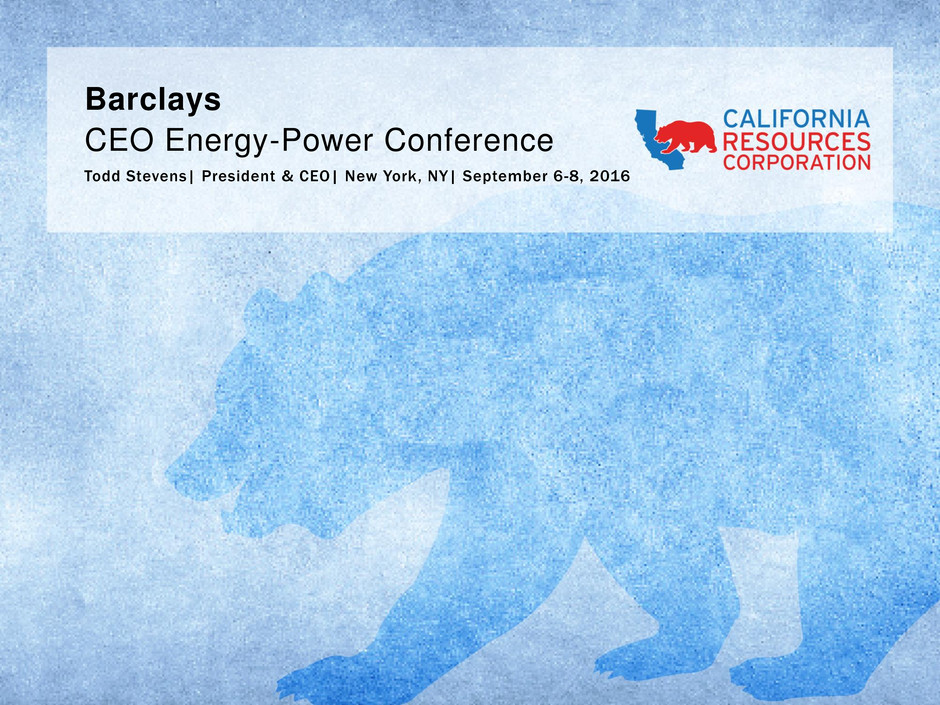
CEO Energy-Power Conference
Barclays
Todd Stevens| President & CEO| New York, NY| September 6-8, 2016
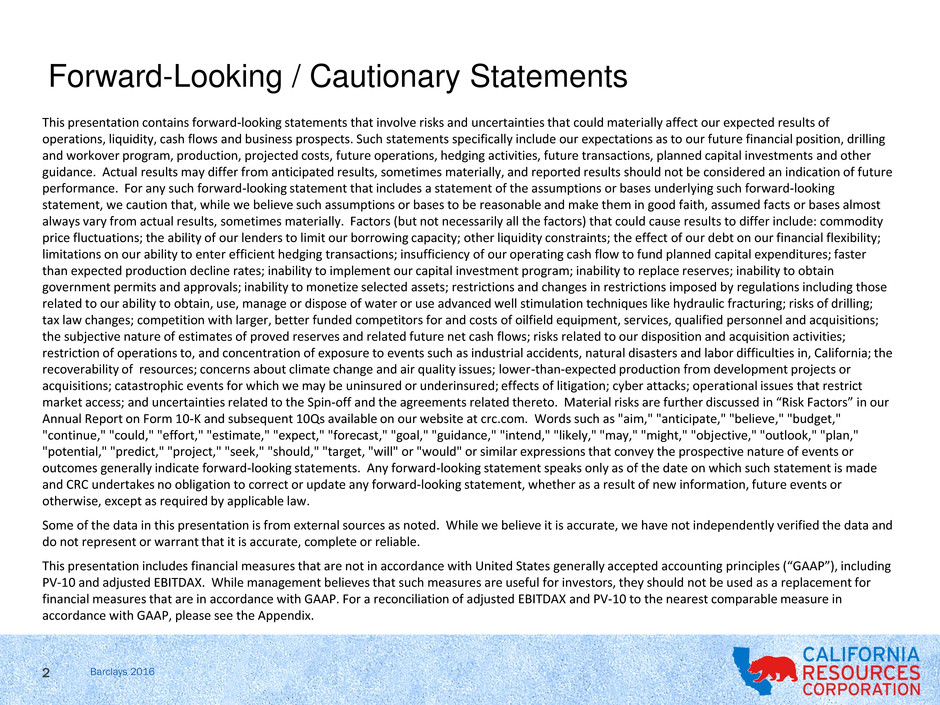
Barclays 2016
Forward-Looking / Cautionary Statements
This presentation contains forward-looking statements that involve risks and uncertainties that could materially affect our expected results of
operations, liquidity, cash flows and business prospects. Such statements specifically include our expectations as to our future financial position, drilling
and workover program, production, projected costs, future operations, hedging activities, future transactions, planned capital investments and other
guidance. Actual results may differ from anticipated results, sometimes materially, and reported results should not be considered an indication of future
performance. For any such forward-looking statement that includes a statement of the assumptions or bases underlying such forward-looking
statement, we caution that, while we believe such assumptions or bases to be reasonable and make them in good faith, assumed facts or bases almost
always vary from actual results, sometimes materially. Factors (but not necessarily all the factors) that could cause results to differ include: commodity
price fluctuations; the ability of our lenders to limit our borrowing capacity; other liquidity constraints; the effect of our debt on our financial flexibility;
limitations on our ability to enter efficient hedging transactions; insufficiency of our operating cash flow to fund planned capital expenditures; faster
than expected production decline rates; inability to implement our capital investment program; inability to replace reserves; inability to obtain
government permits and approvals; inability to monetize selected assets; restrictions and changes in restrictions imposed by regulations including those
related to our ability to obtain, use, manage or dispose of water or use advanced well stimulation techniques like hydraulic fracturing; risks of drilling;
tax law changes; competition with larger, better funded competitors for and costs of oilfield equipment, services, qualified personnel and acquisitions;
the subjective nature of estimates of proved reserves and related future net cash flows; risks related to our disposition and acquisition activities;
restriction of operations to, and concentration of exposure to events such as industrial accidents, natural disasters and labor difficulties in, California; the
recoverability of resources; concerns about climate change and air quality issues; lower-than-expected production from development projects or
acquisitions; catastrophic events for which we may be uninsured or underinsured; effects of litigation; cyber attacks; operational issues that restrict
market access; and uncertainties related to the Spin-off and the agreements related thereto. Material risks are further discussed in “Risk Factors” in our
Annual Report on Form 10-K and subsequent 10Qs available on our website at crc.com. Words such as "aim," "anticipate," "believe," "budget,"
"continue," "could," "effort," "estimate," "expect," "forecast," "goal," "guidance," "intend," "likely," "may," "might," "objective," "outlook," "plan,"
"potential," "predict," "project," "seek," "should," "target, "will" or "would" or similar expressions that convey the prospective nature of events or
outcomes generally indicate forward-looking statements. Any forward-looking statement speaks only as of the date on which such statement is made
and CRC undertakes no obligation to correct or update any forward-looking statement, whether as a result of new information, future events or
otherwise, except as required by applicable law.
Some of the data in this presentation is from external sources as noted. While we believe it is accurate, we have not independently verified the data and
do not represent or warrant that it is accurate, complete or reliable.
This presentation includes financial measures that are not in accordance with United States generally accepted accounting principles (“GAAP”), including
PV-10 and adjusted EBITDAX. While management believes that such measures are useful for investors, they should not be used as a replacement for
financial measures that are in accordance with GAAP. For a reconciliation of adjusted EBITDAX and PV-10 to the nearest comparable measure in
accordance with GAAP, please see the Appendix.
2
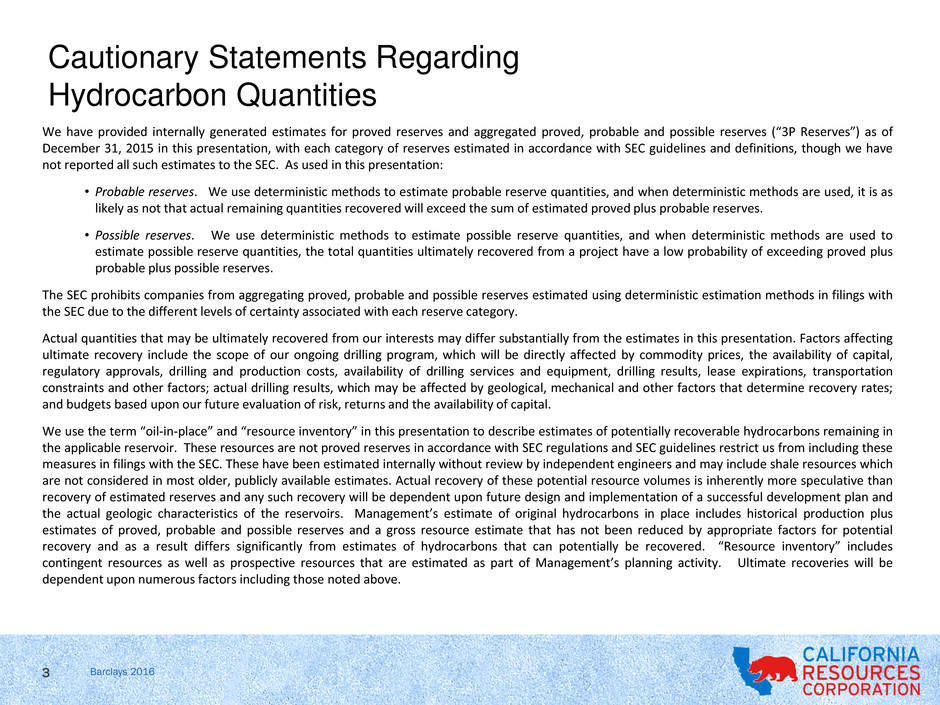
Barclays 2016
Cautionary Statements Regarding
Hydrocarbon Quantities
We have provided internally generated estimates for proved reserves and aggregated proved, probable and possible reserves (“3P Reserves”) as of
December 31, 2015 in this presentation, with each category of reserves estimated in accordance with SEC guidelines and definitions, though we have
not reported all such estimates to the SEC. As used in this presentation:
• Probable reserves. We use deterministic methods to estimate probable reserve quantities, and when deterministic methods are used, it is as
likely as not that actual remaining quantities recovered will exceed the sum of estimated proved plus probable reserves.
• Possible reserves. We use deterministic methods to estimate possible reserve quantities, and when deterministic methods are used to
estimate possible reserve quantities, the total quantities ultimately recovered from a project have a low probability of exceeding proved plus
probable plus possible reserves.
The SEC prohibits companies from aggregating proved, probable and possible reserves estimated using deterministic estimation methods in filings with
the SEC due to the different levels of certainty associated with each reserve category.
Actual quantities that may be ultimately recovered from our interests may differ substantially from the estimates in this presentation. Factors affecting
ultimate recovery include the scope of our ongoing drilling program, which will be directly affected by commodity prices, the availability of capital,
regulatory approvals, drilling and production costs, availability of drilling services and equipment, drilling results, lease expirations, transportation
constraints and other factors; actual drilling results, which may be affected by geological, mechanical and other factors that determine recovery rates;
and budgets based upon our future evaluation of risk, returns and the availability of capital.
We use the term “oil-in-place” and “resource inventory” in this presentation to describe estimates of potentially recoverable hydrocarbons remaining in
the applicable reservoir. These resources are not proved reserves in accordance with SEC regulations and SEC guidelines restrict us from including these
measures in filings with the SEC. These have been estimated internally without review by independent engineers and may include shale resources which
are not considered in most older, publicly available estimates. Actual recovery of these potential resource volumes is inherently more speculative than
recovery of estimated reserves and any such recovery will be dependent upon future design and implementation of a successful development plan and
the actual geologic characteristics of the reservoirs. Management’s estimate of original hydrocarbons in place includes historical production plus
estimates of proved, probable and possible reserves and a gross resource estimate that has not been reduced by appropriate factors for potential
recovery and as a result differs significantly from estimates of hydrocarbons that can potentially be recovered. “Resource inventory” includes
contingent resources as well as prospective resources that are estimated as part of Management’s planning activity. Ultimate recoveries will be
dependent upon numerous factors including those noted above.
3
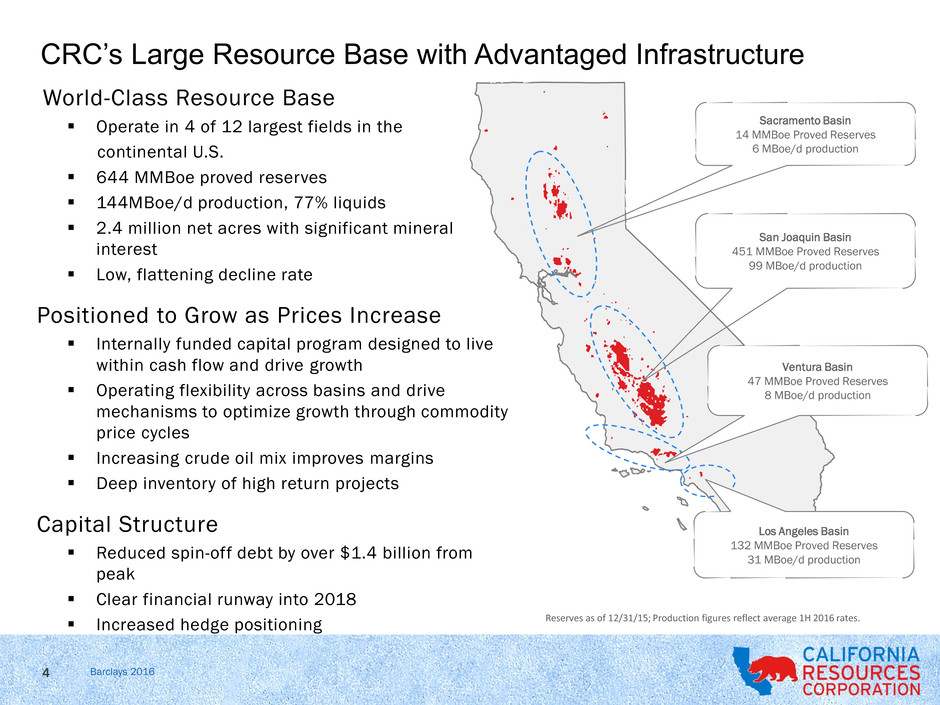
Barclays 2016 NY00813G / 589203_1.WOR
Sacramento Basin
14 MMBoe Proved Reserves
6 MBoe/d production
San Joaquin Basin
451 MMBoe Proved Reserves
99 MBoe/d production
Ventura Basin
47 MMBoe Proved Reserves
8 MBoe/d production
Los Angeles Basin
132 MMBoe Proved Reserves
31 MBoe/d production
World-Class Resource Base
Operate in 4 of 12 largest fields in the
continental U.S.
644 MMBoe proved reserves
144MBoe/d production, 77% liquids
2.4 million net acres with significant mineral
interest
Low, flattening decline rate
Positioned to Grow as Prices Increase
Internally funded capital program designed to live
within cash flow and drive growth
Operating flexibility across basins and drive
mechanisms to optimize growth through commodity
price cycles
Increasing crude oil mix improves margins
Deep inventory of high return projects
Capital Structure
Reduced spin-off debt by over $1.4 billion from
peak
Clear financial runway into 2018
Increased hedge positioning
CRC’s Large Resource Base with Advantaged Infrastructure
Reserves as of 12/31/15; Production figures reflect average 1H 2016 rates.
4
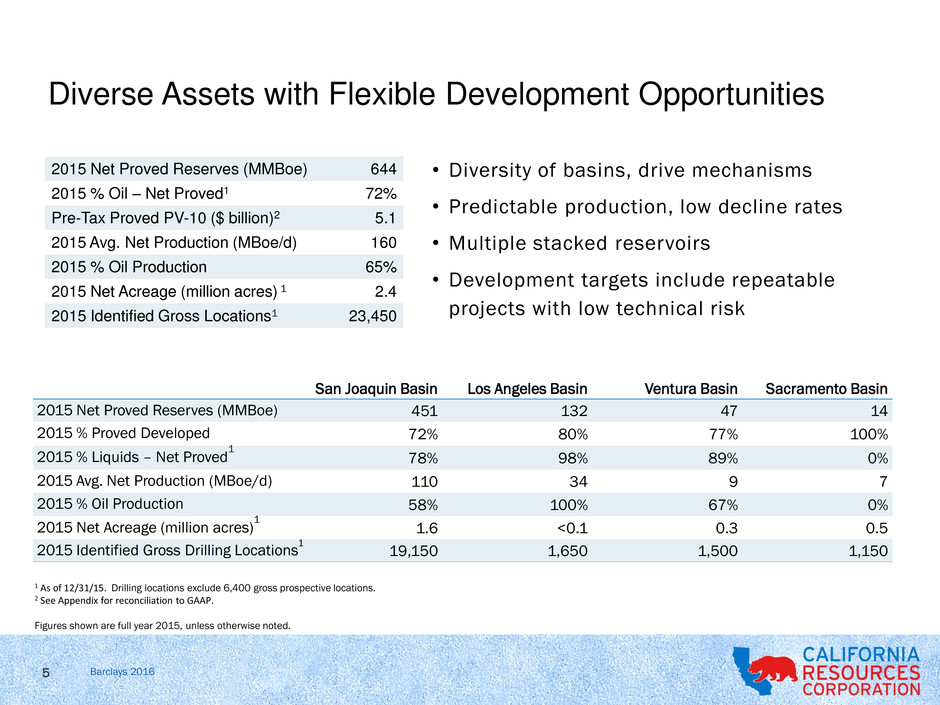
Barclays 2016
2015 Net Proved Reserves (MMBoe) 644
2015 % Oil – Net Proved1 72%
Pre-Tax Proved PV-10 ($ billion)2 5.1
2015 Avg. Net Production (MBoe/d) 160
2015 % Oil Production 65%
2015 Net Acreage (million acres) 1 2.4
2015 Identified Gross Locations1 23,450
1 As of 12/31/15. Drilling locations exclude 6,400 gross prospective locations.
2 See Appendix for reconciliation to GAAP.
Figures shown are full year 2015, unless otherwise noted.
San Joaquin Basin Los Angeles Basin Ventura Basin Sacramento Basin
2015 Net Proved Reserves (MMBoe) 451 132 47 14
2015 % Proved Developed 72% 80% 77% 100%
2015 % Liquids – Net Proved
1
78% 98% 89% 0%
2015 Avg. Net Production (MBoe/d) 110 34 9 7
2015 % Oil Production 58% 100% 67% 0%
2015 Net Acreage (million acres)
1
1.6 <0.1 0.3 0.5
2015 Identified Gross Drilling Locations
1
19,150 1,650 1,500 1,150
Diverse Assets with Flexible Development Opportunities
• Diversity of basins, drive mechanisms
• Predictable production, low decline rates
• Multiple stacked reservoirs
• Development targets include repeatable
projects with low technical risk
5
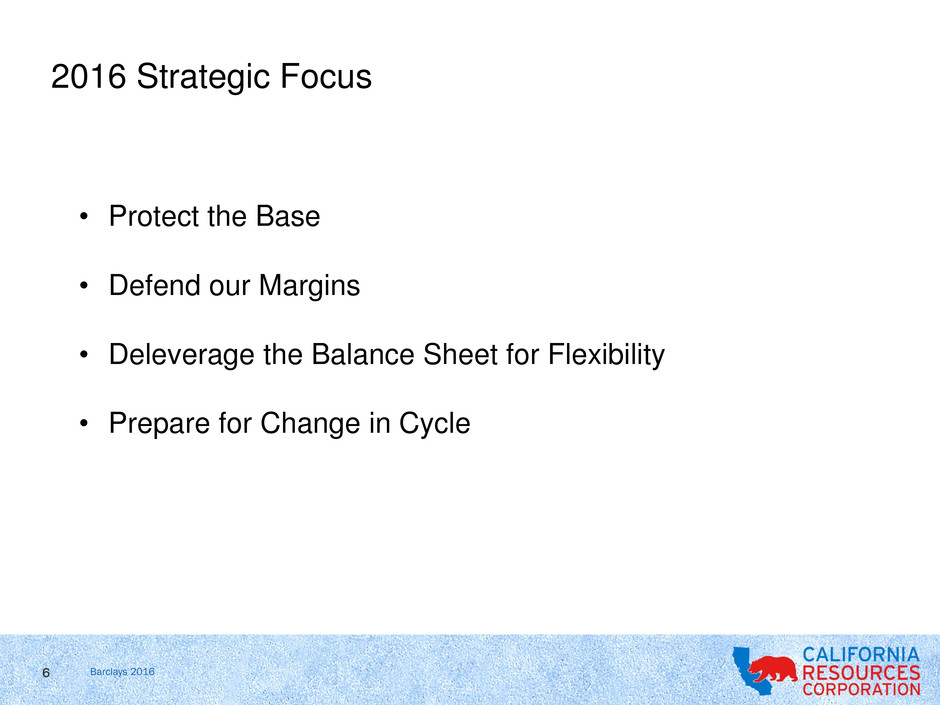
Barclays 20166
2016 Strategic Focus
• Protect the Base
• Defend our Margins
• Deleverage the Balance Sheet for Flexibility
• Prepare for Change in Cycle
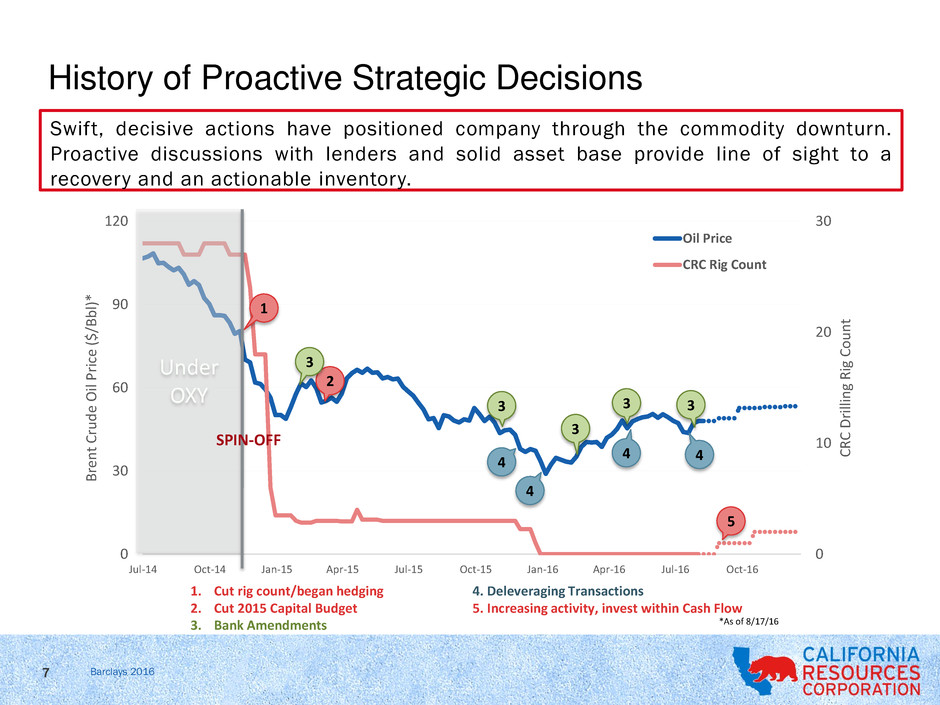
Barclays 2016
History of Proactive Strategic Decisions
7
Swift, decisive actions have positioned company through the commodity downturn.
Proactive discussions with lenders and solid asset base provide line of sight to a
recovery and an actionable inventory.
0
10
20
30
0
30
60
90
120
Jul-14 Oct-14 Jan-15 Apr-15 Jul-15 Oct-15 Jan-16 Apr-16 Jul-16 Oct-16
C
R
C
D
rilli
n
g
Ri
g
C
o
u
n
t
B
re
n
t
C
ru
d
e
Oil
P
rice
($
/B
b
l)
*
Oil Price
CRC Rig Count
Under
OXY
SPIN-OFF
4
3
2
1
4
*As of 8/17/16
5
3
3
1. Cut rig count/began hedging 4. Deleveraging Transactions
2. Cut 2015 Capital Budget 5. Increasing activity, invest within Cash Flow
3. Bank Amendments
4
4
3
3
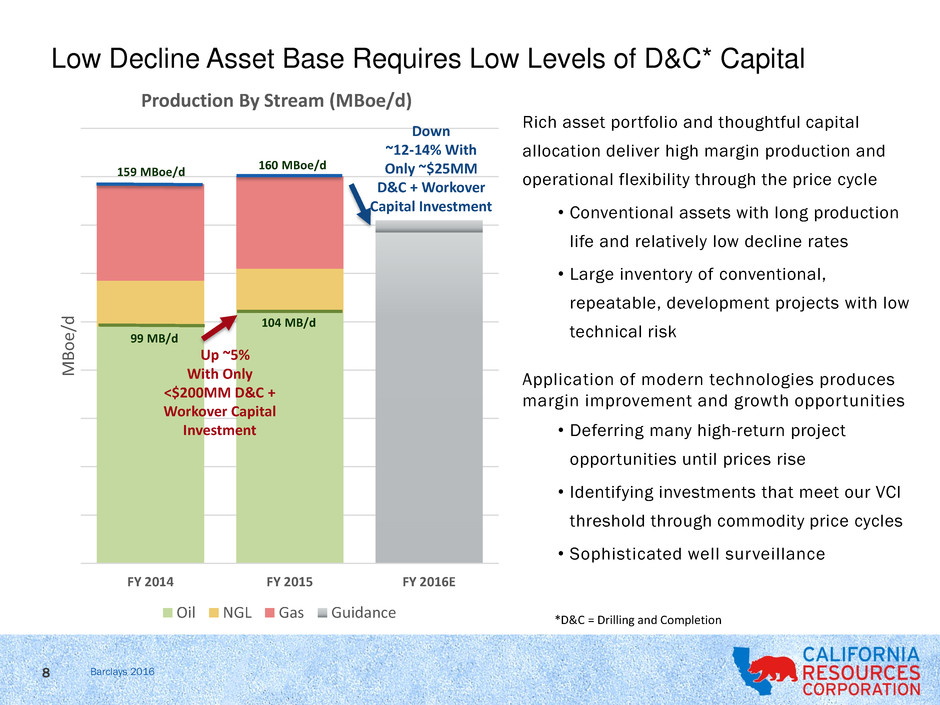
Barclays 2016
Low Decline Asset Base Requires Low Levels of D&C* Capital
Rich asset portfolio and thoughtful capital
allocation deliver high margin production and
operational flexibility through the price cycle
• Conventional assets with long production
life and relatively low decline rates
• Large inventory of conventional,
repeatable, development projects with low
technical risk
Application of modern technologies produces
margin improvement and growth opportunities
• Deferring many high-return project
opportunities until prices rise
• Identifying investments that meet our VCI
threshold through commodity price cycles
• Sophisticated well surveillance
8
FY 2014 FY 2015 FY 2016E
MB
o
e/
d
Production By Stream (MBoe/d)
Oil NGL Gas Guidance
99 MB/d
104 MB/d
Down
~12-14% With
Only ~$25MM
D&C + Workover
Capital Investment
Up ~5%
With Only
<$200MM D&C +
Workover Capital
Investment
160 MBoe/d
159 MBoe/d
*D&C = Drilling and Completion
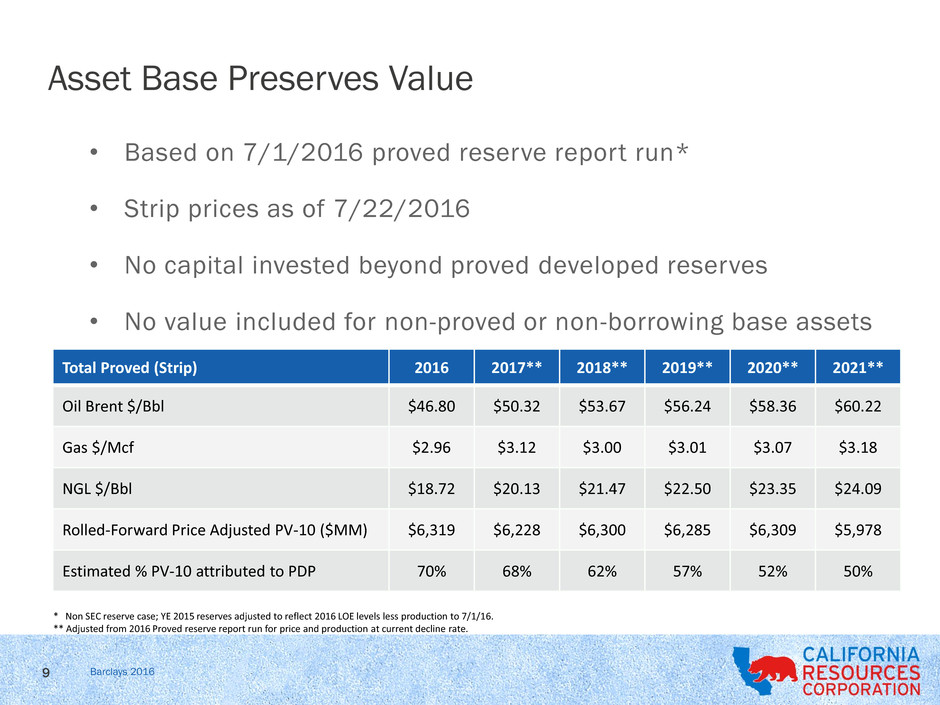
Barclays 2016
Asset Base Preserves Value
9
• Based on 7/1/2016 proved reserve report run*
• Strip prices as of 7/22/2016
• No capital invested beyond proved developed reserves
• No value included for non-proved or non-borrowing base assets
Total Proved (Strip) 2016 2017** 2018** 2019** 2020** 2021**
Oil Brent $/Bbl $46.80 $50.32 $53.67 $56.24 $58.36 $60.22
Gas $/Mcf $2.96 $3.12 $3.00 $3.01 $3.07 $3.18
NGL $/Bbl $18.72 $20.13 $21.47 $22.50 $23.35 $24.09
Rolled-Forward Price Adjusted PV-10 ($MM) $6,319 $6,228 $6,300 $6,285 $6,309 $5,978
Estimated % PV-10 attributed to PDP 70% 68% 62% 57% 52% 50%
* Non SEC reserve case; YE 2015 reserves adjusted to reflect 2016 LOE levels less production to 7/1/16.
** Adjusted from 2016 Proved reserve report run for price and production at current decline rate.
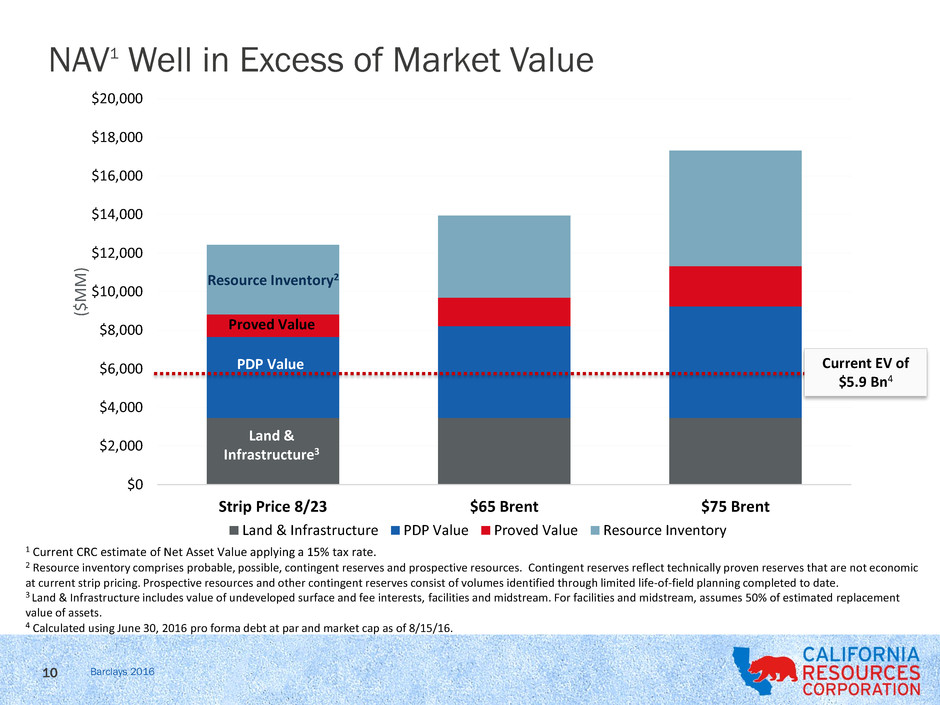
Barclays 2016
NAV1 Well in Excess of Market Value
10
1 Current CRC estimate of Net Asset Value applying a 15% tax rate.
2 Resource inventory comprises probable, possible, contingent reserves and prospective resources. Contingent reserves reflect technically proven reserves that are not economic
at current strip pricing. Prospective resources and other contingent reserves consist of volumes identified through limited life-of-field planning completed to date.
3 Land & Infrastructure includes value of undeveloped surface and fee interests, facilities and midstream. For facilities and midstream, assumes 50% of estimated replacement
value of assets.
4 Calculated using June 30, 2016 pro forma debt at par and market cap as of 8/15/16.
Land &
Infrastructure3
PDP Value
Proved Value
Resource Inventory2
$0
$2,000
$4,000
$6,000
$8,000
$10,000
$12,000
$14,000
$16,000
$18,000
$20,000
Strip Price 8/23 $65 Brent $75 Brent
($MM
)
Land & Infrastructure PDP Value Proved Value Resource Inventory
Current EV of
$5.9 Bn4
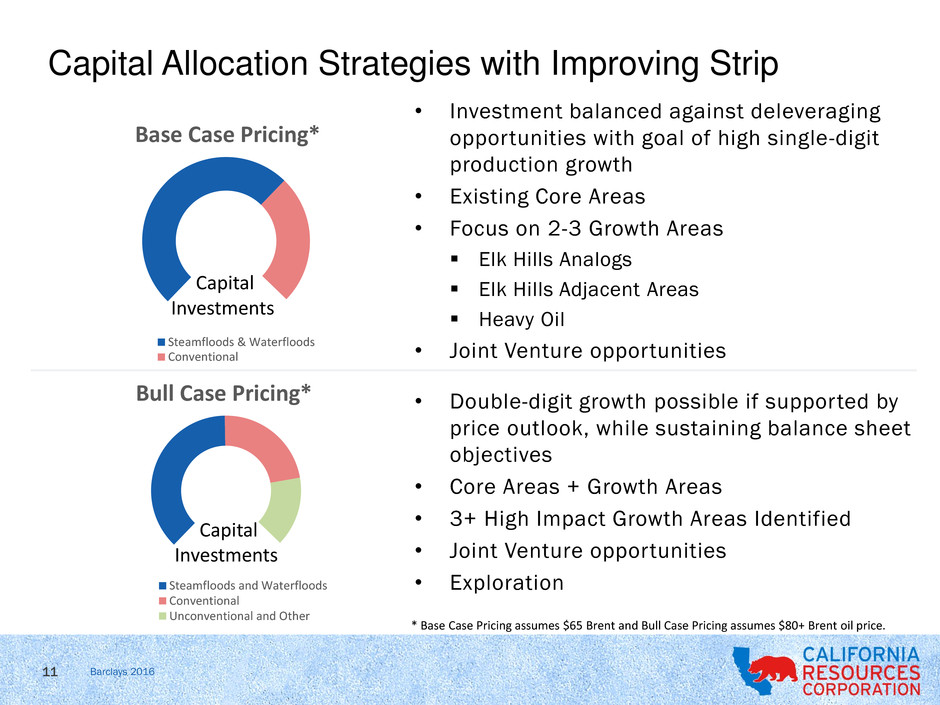
Barclays 2016
• Investment balanced against deleveraging
opportunities with goal of high single-digit
production growth
• Existing Core Areas
• Focus on 2-3 Growth Areas
Elk Hills Analogs
Elk Hills Adjacent Areas
Heavy Oil
• Joint Venture opportunities
• Double-digit growth possible if supported by
price outlook, while sustaining balance sheet
objectives
• Core Areas + Growth Areas
• 3+ High Impact Growth Areas Identified
• Joint Venture opportunities
• Exploration
Capital Allocation Strategies with Improving Strip
11
Base Case Pricing*
Steamfloods & Waterfloods
Conventional
Bull Case Pricing*
Steamfloods and Waterfloods
Conventional
Unconventional and Other
Capital
Investments
Capital
Investments
* Base Case Pricing assumes $65 Brent and Bull Case Pricing assumes $80+ Brent oil price.
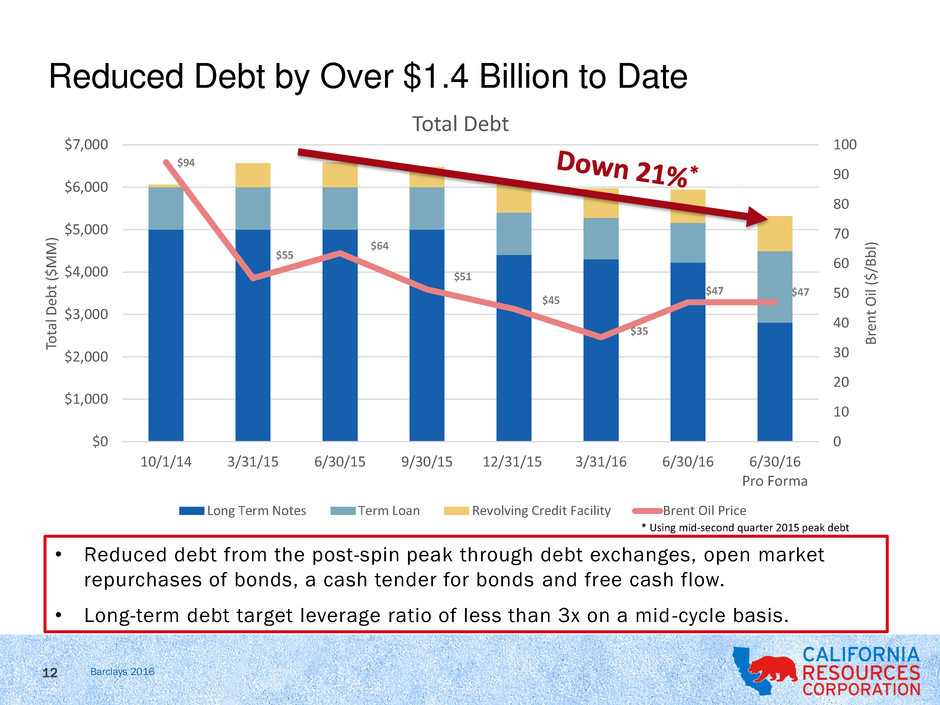
Barclays 2016
$94
$55
$64
$51
$45
$35
$47 $47
0
10
20
30
40
50
60
70
80
90
100
$0
$1,000
$2,000
$3,000
$4,000
$5,000
$6,000
$7,000
10/1/14 3/31/15 6/30/15 9/30/15 12/31/15 3/31/16 6/30/16 6/30/16
Pro Forma
B
re
n
t
Oil ($
/B
b
l)
Total
D
eb
t
($
M
M
)
Total Debt
Long Term Notes Term Loan Revolving Credit Facility Brent Oil Price
Reduced Debt by Over $1.4 Billion to Date
12
• Reduced debt from the post-spin peak through debt exchanges, open market
repurchases of bonds, a cash tender for bonds and free cash flow.
• Long-term debt target leverage ratio of less than 3x on a mid -cycle basis.
* Using mid-second quarter 2015 peak debt
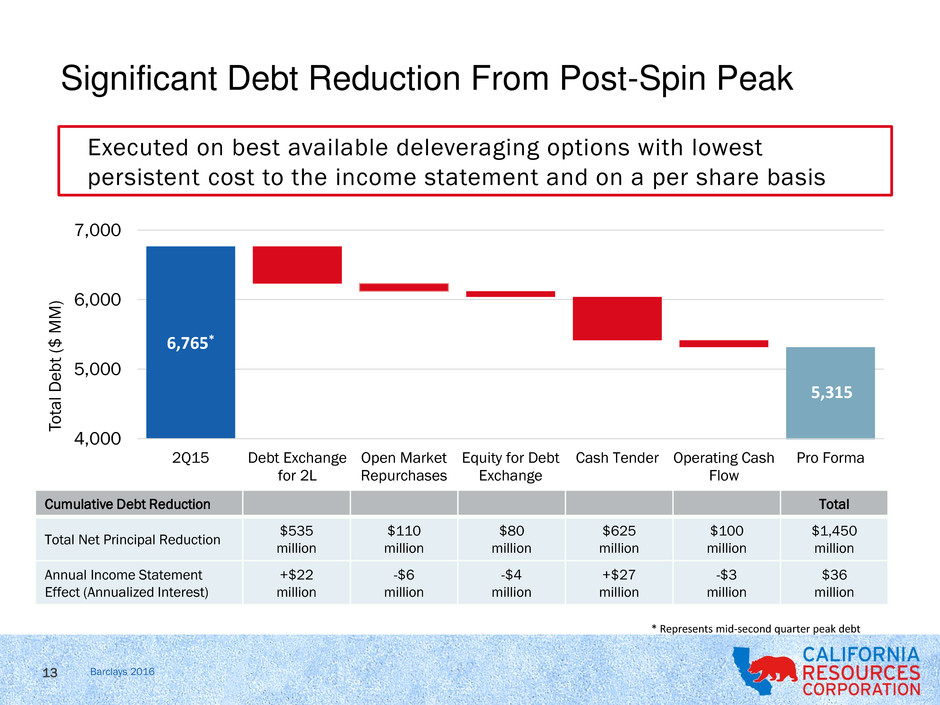
Barclays 2016
6,765*
5,315
4,000
5,000
6,000
7,000
2Q15 Debt Exchange
for 2L
Open Market
Repurchases
Equity for Debt
Exchange
Cash Tender Operating Cash
Flow
Pro Forma
To
ta
l D
e
b
t
($
MM
)
Significant Debt Reduction From Post-Spin Peak
Executed on best available deleveraging options with lowest
persistent cost to the income statement and on a per share basis
13
Cumulative Debt Reduction Total
Total Net Principal Reduction
$535
million
$110
million
$80
million
$625
million
$100
million
$1,450
million
Annual Income Statement
Effect (Annualized Interest)
+$22
million
-$6
million
-$4
million
+$27
million
-$3
million
$36
million
* Represents mid-second quarter peak debt
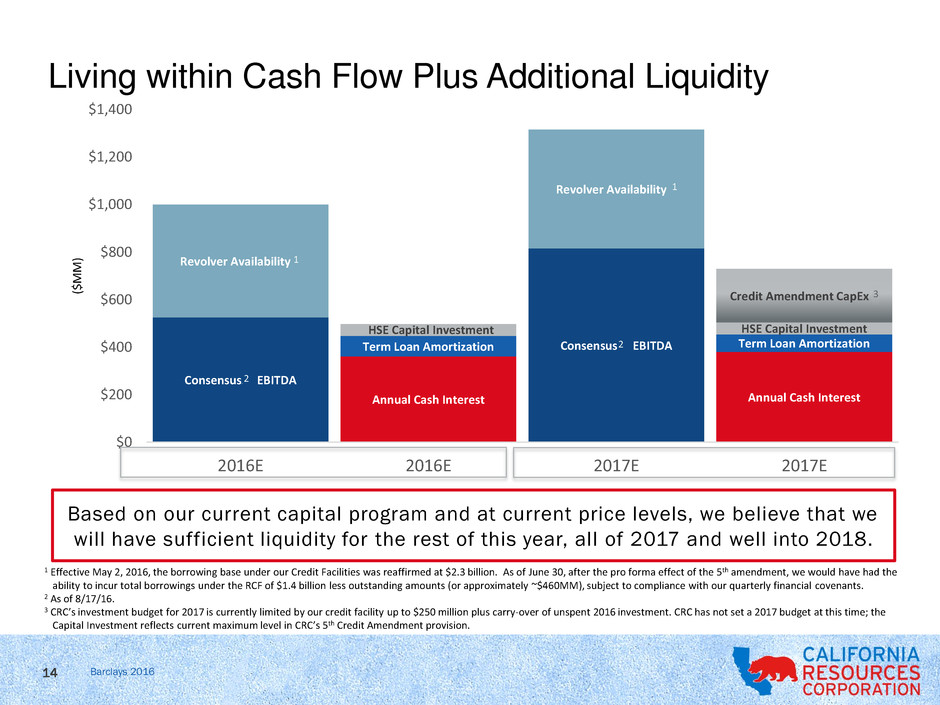
Barclays 2016
Living within Cash Flow Plus Additional Liquidity
14
Based on our current capital program and at current price levels, we believe that we
will have sufficient liquidity for the rest of this year, all of 2017 and well into 2018.
Consensus2 EBITDA
Consensus2 EBITDA
Revolver Availability 1
Revolver Availability 1
Annual Cash Interest Annual Cash Interest
Term Loan Amortization Term Loan Amortization
HSE Capital Investment HSE Capital Investment
Credit Amendment CapEx 2
$0
$200
$400
$600
$800
$1,000
$1,200
$1,400
2016E 2016E 2017E 2017E
($MM
)
2
1 Effective May 2, 2016, the borrowing base under our Credit Facilities was reaffirmed at $2.3 billion. As of June 30, after the pro forma effect of the 5th amendment, we would have had the
ability to incur total borrowings under the RCF of $1.4 billion less outstanding amounts (or approximately ~$460MM), subject to compliance with our quarterly financial covenants.
2 As of 8/17/16.
3 CRC’s investment budget for 2017 is currently limited by our credit facility up to $250 million plus carry-over of unspent 2016 investment. CRC has not set a 2017 budget at this time; the
Capital Investment reflects current maximum level in CRC’s 5th Credit Amendment provision.
1
1
3
2
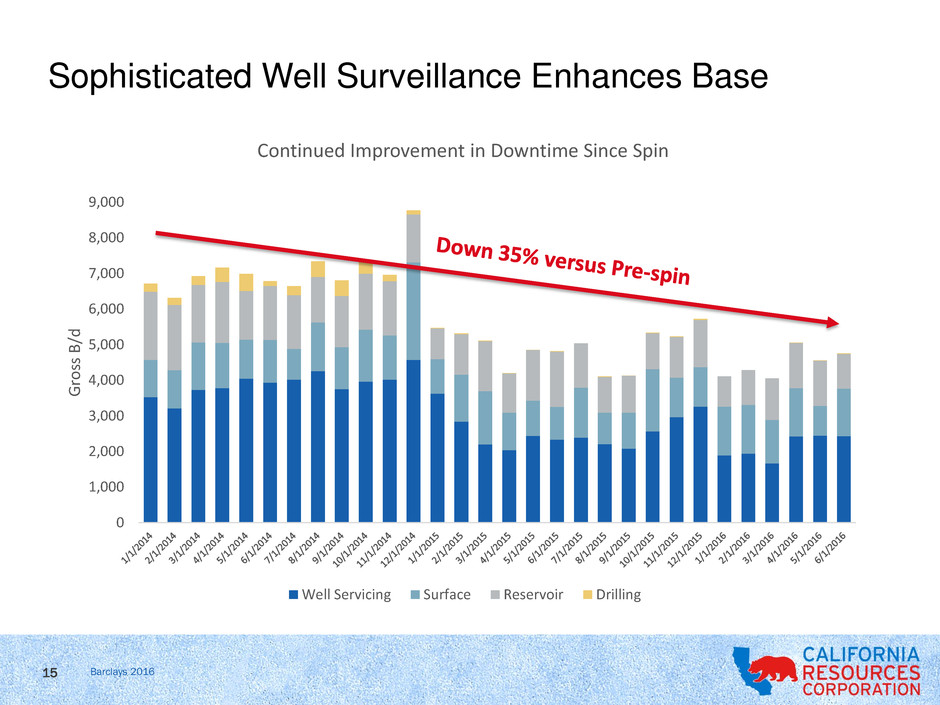
Barclays 2016
Sophisticated Well Surveillance Enhances Base
15
0
1,000
2,000
3,000
4,000
5,000
6,000
7,000
8,000
9,000
G
ro
ss
B
/d
Continued Improvement in Downtime Since Spin
Well Servicing Surface Reservoir Drilling
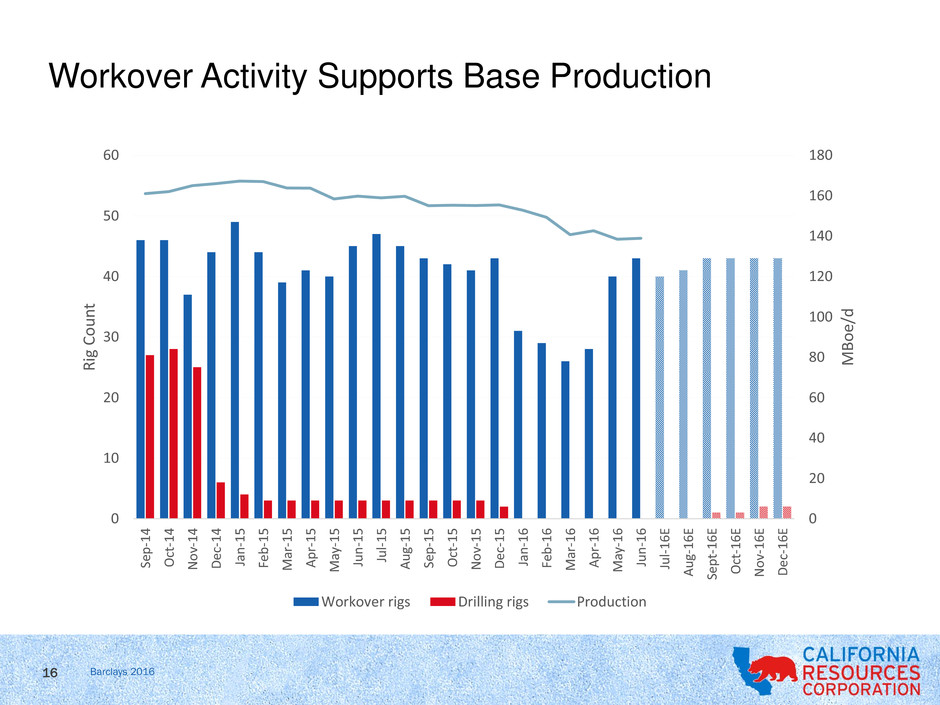
Barclays 2016
Workover Activity Supports Base Production
16
0
20
40
60
80
100
120
140
160
180
0
10
20
30
40
50
60
Se
p
-1
4
O
ct-
1
4
N
o
v-
14
D
ec-
1
4
Ja
n
-1
5
Fe
b
-1
5
M
ar
-1
5
A
p
r-1
5
M
ay-
1
5
Ju
n
-1
5
Ju
l-
1
5
A
u
g-1
5
Se
p
-1
5
O
ct-
1
5
N
o
v-
15
D
ec-
1
5
Ja
n
-1
6
Fe
b
-1
6
M
ar
-1
6
A
p
r-1
6
M
ay-
1
6
Ju
n
-1
6
Ju
l-
1
6E
A
u
g-1
6
E
Se
p
t-
16
E
O
ct-1
6
E
N
o
v-
16
E
D
ec-
1
6
E
MBo
e/
d
R
ig
C
o
u
n
t
Workover rigs Drilling rigs Production
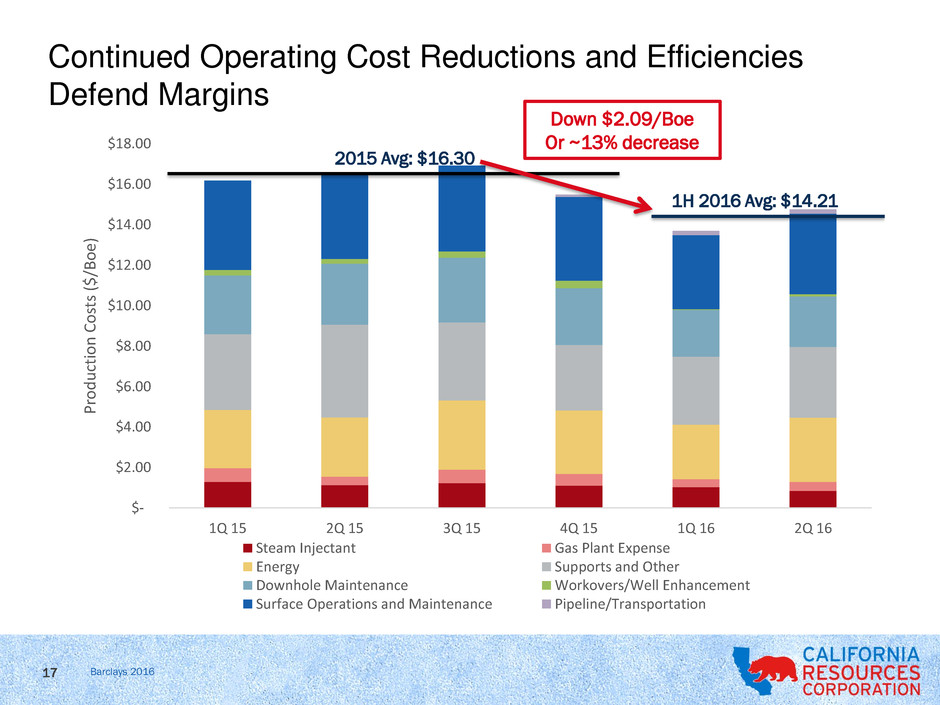
Barclays 2016
$-
$2.00
$4.00
$6.00
$8.00
$10.00
$12.00
$14.00
$16.00
$18.00
1Q 15 2Q 15 3Q 15 4Q 15 1Q 16 2Q 16
P
ro
d
u
ct
io
n
C
o
st
s ($
/B
o
e)
Steam Injectant Gas Plant Expense
Energy Supports and Other
Downhole Maintenance Workovers/Well Enhancement
Surface Operations and Maintenance Pipeline/Transportation
17
Continued Operating Cost Reductions and Efficiencies
Defend Margins
1H 2016 Avg: $14.21
2015 Avg: $16.30
Down $2.09/Boe
Or ~13% decrease
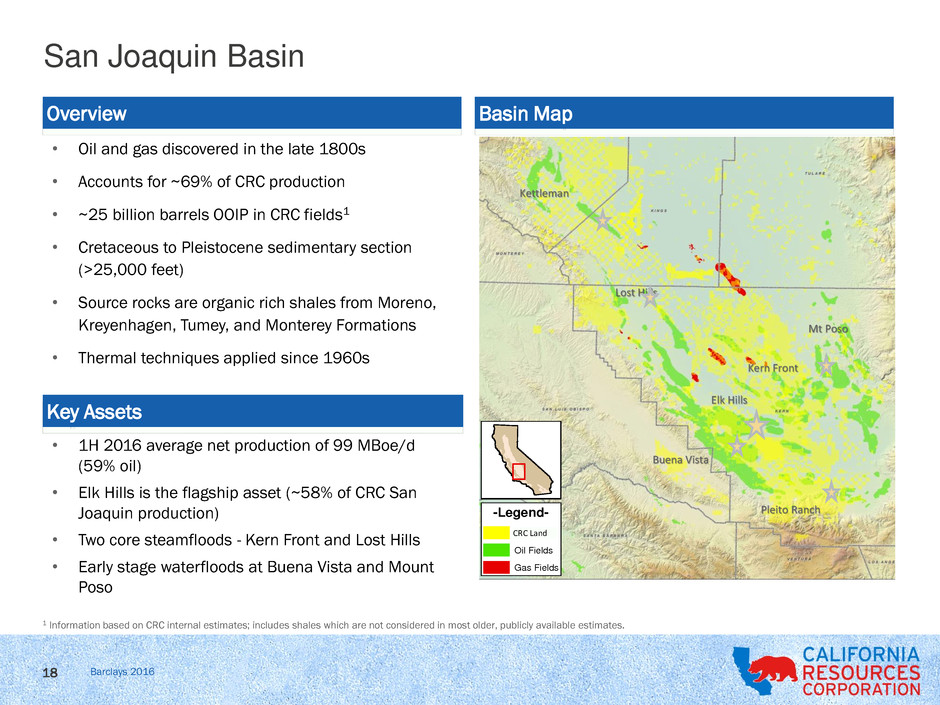
Barclays 2016
San Joaquin Basin
• Oil and gas discovered in the late 1800s
• Accounts for ~69% of CRC production
• ~25 billion barrels OOIP in CRC fields1
• Cretaceous to Pleistocene sedimentary section
(>25,000 feet)
• Source rocks are organic rich shales from Moreno,
Kreyenhagen, Tumey, and Monterey Formations
• Thermal techniques applied since 1960s
• 1H 2016 average net production of 99 MBoe/d
(59% oil)
• Elk Hills is the flagship asset (~58% of CRC San
Joaquin production)
• Two core steamfloods - Kern Front and Lost Hills
• Early stage waterfloods at Buena Vista and Mount
Poso
Overview
Key Assets
Basin Map
-Legend-
Oxy Land
Oil Fields
Gas Fields
Buena Vista
Pleito Ranch
Elk Hills
Kettleman
Lost Hills
Mt Poso
CRC Land
Kern Front
1 Information based on CRC internal estimates; includes shales which are not considered in most older, publicly available estimates.
18
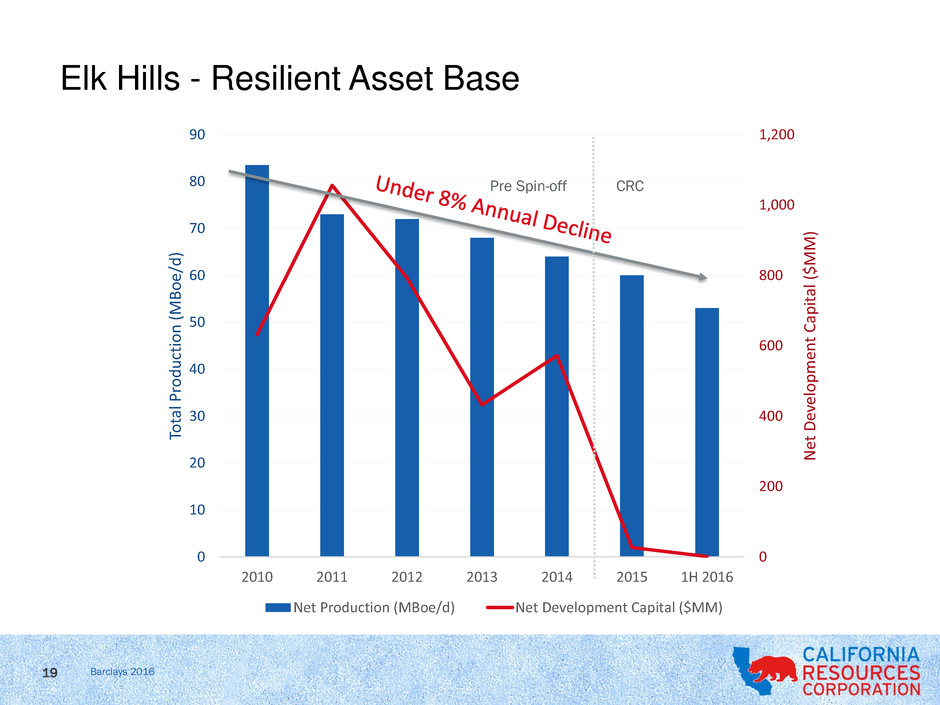
Barclays 2016
0
200
400
600
800
1,000
1,200
0
10
20
30
40
50
60
70
80
90
2010 2011 2012 2013 2014 2015 1H 2016
N
et
D
ev
el
o
pme
n
t
Ca
p
it
al
(
$MM
)
To
ta
l P
ro
d
u
ct
io
n
(
MBo
e/d
)
Net Production (MBoe/d) Net Development Capital ($MM)
CRCPre Spin-off
Elk Hills - Resilient Asset Base
19
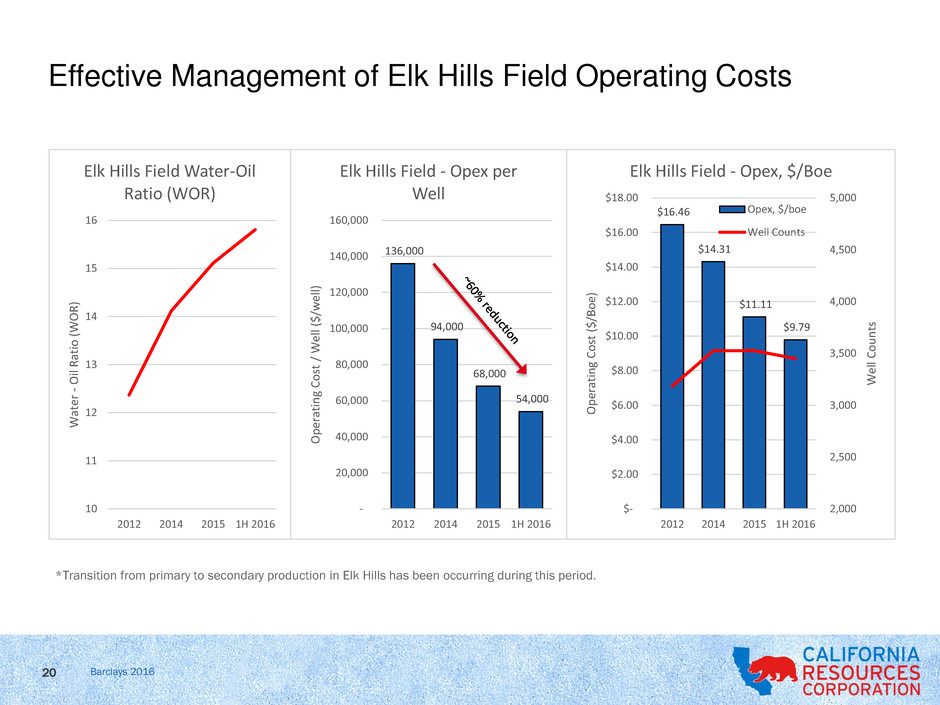
Barclays 2016
Effective Management of Elk Hills Field Operating Costs
20
136,000
94,000
68,000
54,000
-
20,000
40,000
60,000
80,000
100,000
120,000
140,000
160,000
2012 2014 2015 1H 2016
O
p
er
ati
n
g Co
st
/
We
ll
($
/w
ell
)
Elk Hills Field - Opex per
Well
10
11
12
13
14
15
16
2012 2014 2015 1H 2016
W
ater
-
Oil R
ati
o
(W
O
R
)
Elk Hills Field Water-Oil
Ratio (WOR)
$16.46
$14.31
$11.11
$9.79
2,000
2,500
3,000
3,500
4,000
4,500
5,000
$-
$2.00
$4.00
$6.00
$8.00
$10.00
$12.00
$14.00
$16.00
$18.00
2012 2014 2015 1H 2016
We
ll
Co
u
n
ts
O
p
er
ati
n
g
Co
st
($
/Bo
e)
Elk Hills Field - Opex, $/Boe
Opex, $/boe
Well Counts
*Transition from primary to secondary production in Elk Hills has been occurring during this period.
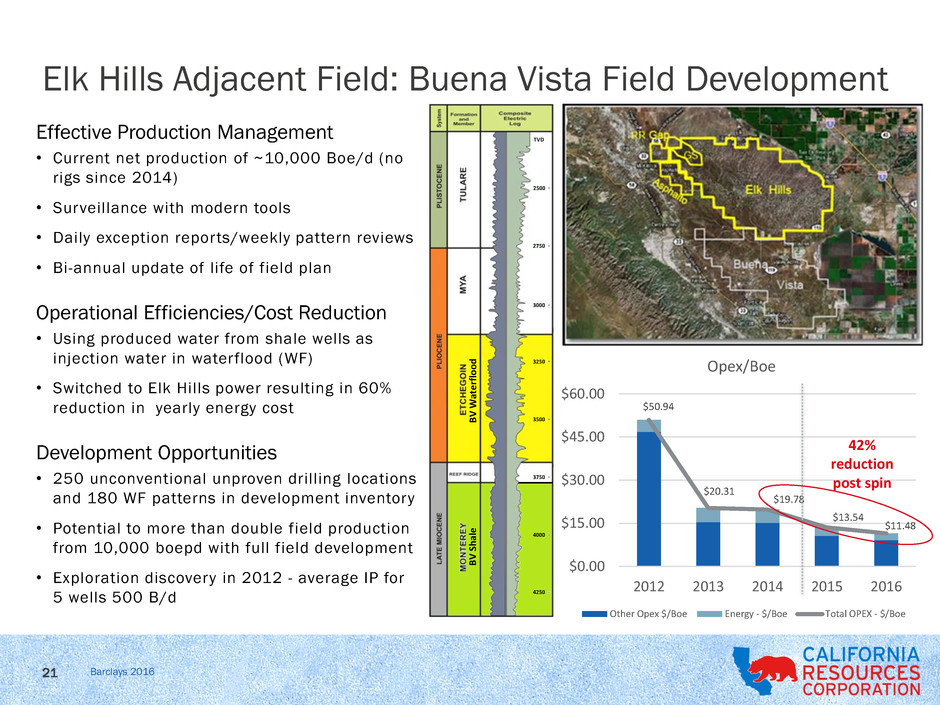
Barclays 2016
Elk Hills Adjacent Field: Buena Vista Field Development
21
2500
TVD
2750
3000
3250
3750
4000
4250
3500
B
V
S
ha
le
B
V
W
at
e
rf
loo
d
Effective Production Management
• Current net production of ~10,000 Boe/d (no
rigs since 2014)
• Surveillance with modern tools
• Daily exception reports/weekly pattern reviews
• Bi-annual update of life of field plan
Operational Efficiencies/Cost Reduction
• Using produced water from shale wells as
injection water in waterflood (WF)
• Switched to Elk Hills power resulting in 60%
reduction in yearly energy cost
Development Opportunities
• 250 unconventional unproven drilling locations
and 180 WF patterns in development inventory
• Potential to more than double field production
from 10,000 boepd with full field development
• Exploration discovery in 2012 - average IP for
5 wells 500 B/d
$50.94
$20.31
$19.78
$13.54
$11.48
$0.00
$15.00
$30.00
$45.00
$60.00
2012 2013 2014 2015 2016
Opex/Boe
Other Opex $/Boe Energy - $/Boe Total OPEX - $/Boe
42%
reduction
post spin
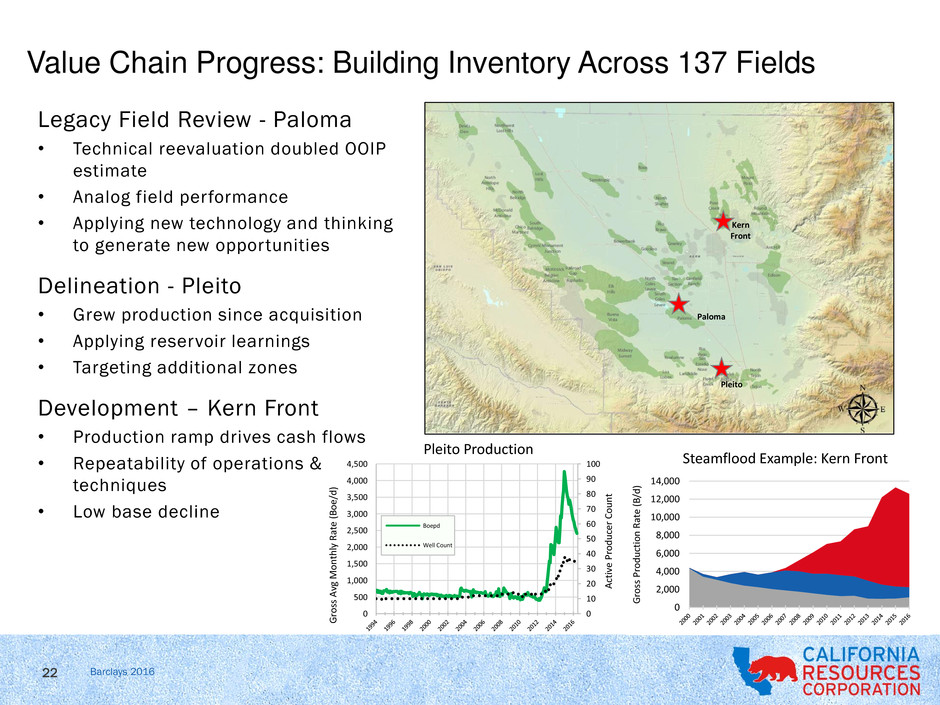
Barclays 2016
Value Chain Progress: Building Inventory Across 137 Fields
22
Legacy Field Review - Paloma
• Technical reevaluation doubled OOIP
estimate
• Analog field performance
• Applying new technology and thinking
to generate new opportunities
Delineation - Pleito
• Grew production since acquisition
• Applying reservoir learnings
• Targeting additional zones
Development – Kern Front
• Production ramp drives cash flows
• Repeatability of operations &
techniques
• Low base decline
0
10
20
30
40
50
60
70
80
90
100
0
500
1,000
1,500
2,000
2,500
3,000
3,500
4,000
4,500
A
ct
iv
e
P
ro
d
u
ce
r Co
u
n
t
G
ro
ss
A
vg
M
o
n
th
ly
R
at
e
(B
o
e/
d
)
Pleito Production
Boepd
Well Count
0
2,000
4,000
6,000
8,000
10,000
12,000
14,000
G
ro
ss
P
ro
d
u
ct
io
n
R
at
e
(B
/d
)
Steamflood Example: Kern Front
Kern
Front
Paloma
Pleito

Barclays 2016
Progressing Inventory to VCI Threshold
23
Economic Project Inventory
Brent Marker Price ($/Bbl)
0
1,000
2,000
3,000
4,000
5,000
6,000
7,000
2015 2016 2015 2016 2015 2016
$40 $50 $60
Dri
llin
g
an
d
W
o
rk
o
ver
C
ap
ex
(
$
M
M
)
VCI > 1.0
VCI > 1.3
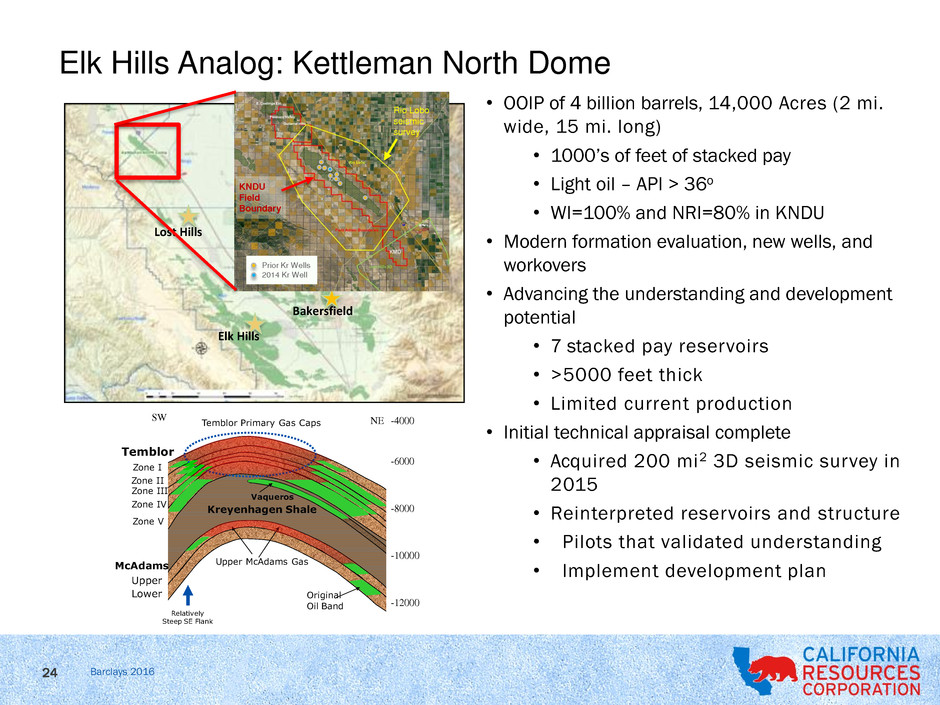
Barclays 2016
Elk Hills Analog: Kettleman North Dome
24
• OOIP of 4 billion barrels, 14,000 Acres (2 mi.
wide, 15 mi. long)
• 1000’s of feet of stacked pay
• Light oil – API > 36o
• WI=100% and NRI=80% in KNDU
• Modern formation evaluation, new wells, and
workovers
• Advancing the understanding and development
potential
• 7 stacked pay reservoirs
• >5000 feet thick
• Limited current production
• Initial technical appraisal complete
• Acquired 200 mi2 3D seismic survey in
2015
• Reinterpreted reservoirs and structure
• Pilots that validated understanding
• Implement development plan
Bakersfield
Elk Hills
Lost Hills
Relatively
Steep SE Flank
-4000
-6000
-8000
-10000
-12000
Temblor
McA ams
Upper
Lower
Zone I
Zone II
Zone III
Zone IV
Zone V
SW NE
Vaqueros
Upper McAdams Gas
Original
Oil Band
Temblor Primary Gas Caps
Kreyenhagen Shale
Prior Kr Wells
2014 Kr Well
Rio Lobo
seismic
survey
KNDU
Field
Boundary
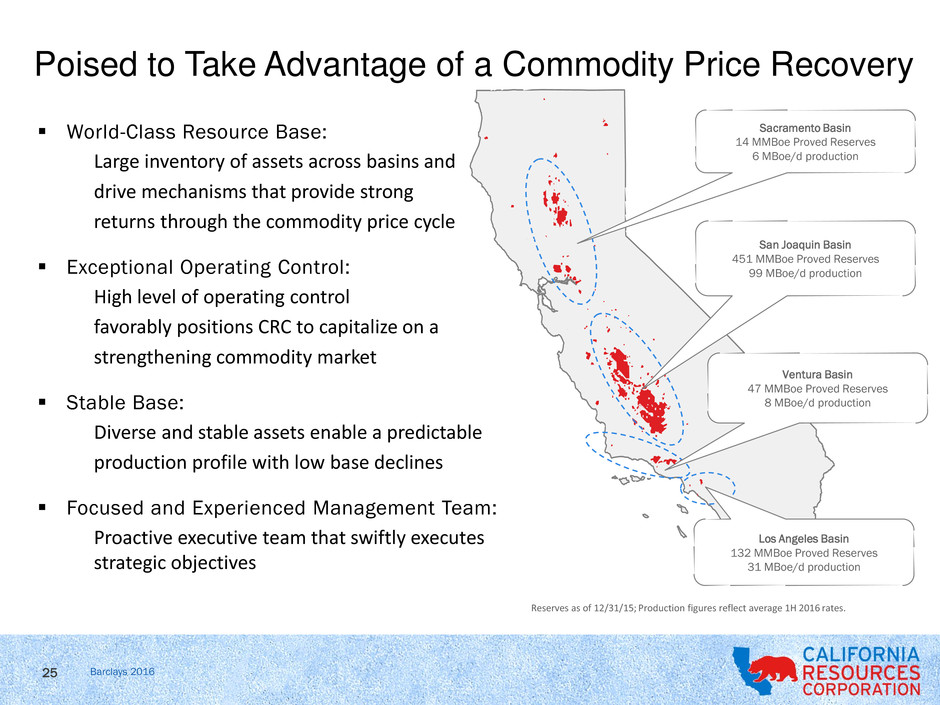
Barclays 2016 NY00813G / 589203_1.WOR
Sacramento Basin
14 MMBoe Proved Reserves
6 MBoe/d production
San Joaquin Basin
451 MMBoe Proved Reserves
99 MBoe/d production
Ventura Basin
47 MMBoe Proved Reserves
8 MBoe/d production
Los Angeles Basin
132 MMBoe Proved Reserves
31 MBoe/d production
World-Class Resource Base:
Large inventory of assets across basins and
drive mechanisms that provide strong
returns through the commodity price cycle
Exceptional Operating Control:
High level of operating control
favorably positions CRC to capitalize on a
strengthening commodity market
Stable Base:
Diverse and stable assets enable a predictable
production profile with low base declines
Focused and Experienced Management Team:
Proactive executive team that swiftly executes
strategic objectives
Poised to Take Advantage of a Commodity Price Recovery
Reserves as of 12/31/15; Production figures reflect average 1H 2016 rates.
25
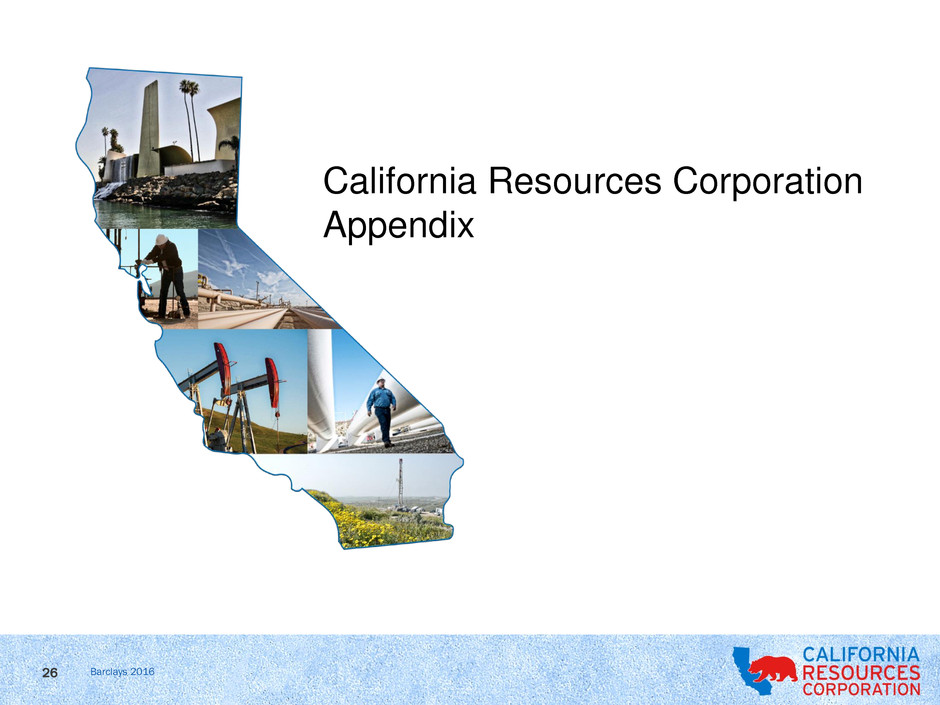
Barclays 2016
California Resources Corporation
Appendix
26
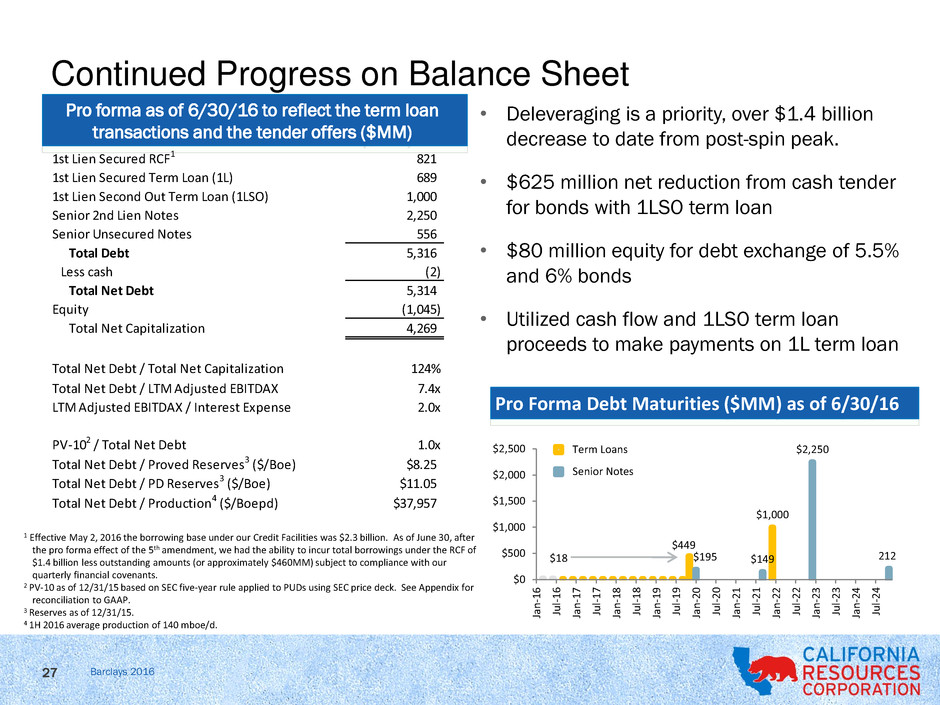
Barclays 2016
Pro forma as of 6/30/16 to reflect the term loan
transactions and the tender offers ($MM)
$18
$449
$1,000
$195 $149
$2,250
212
$0
$500
$1,000
$1,500
$2,000
$2,500
Ja
n
-1
6
Ju
l-1
6
Ja
n
-1
7
Ju
l-1
7
Ja
n
-1
8
Ju
l-1
8
Ja
n
-1
9
Ju
l-1
9
Ja
n
-2
0
Ju
l-2
0
Ja
n
-2
1
Ju
l-2
1
Ja
n
-2
2
Ju
l-2
2
Ja
n
-2
3
Ju
l-2
3
Ja
n
-2
4
Ju
l-2
4
Term Loans
Senior Notes
Pro Forma Debt Maturities ($MM) as of 6/30/16
Continued Progress on Balance Sheet
• Deleveraging is a priority, over $1.4 billion
decrease to date from post-spin peak.
• $625 million net reduction from cash tender
for bonds with 1LSO term loan
• $80 million equity for debt exchange of 5.5%
and 6% bonds
• Utilized cash flow and 1LSO term loan
proceeds to make payments on 1L term loan
1 Effective May 2, 2016 the borrowing base under our Credit Facilities was $2.3 billion. As of June 30, after
the pro forma effect of the 5th amendment, we had the ability to incur total borrowings under the RCF of
$1.4 billion less outstanding amounts (or approximately $460MM) subject to compliance with our
quarterly financial covenants.
2 PV-10 as of 12/31/15 based on SEC five-year rule applied to PUDs using SEC price deck. See Appendix for
reconciliation to GAAP.
3 Reserves as of 12/31/15.
4 1H 2016 average production of 140 mboe/d.
1st Lien Secured RCF1 821
1st Lien Secured Term Loan (1L) 689
1st Lien Second Out Term Loan (1LSO) 1,000
Senior 2nd Lien Notes 2,250
Senior Unsecured Notes 556
Total Debt 5,316
Less cash (2)
Total Net Debt 5,314
Equity (1,045)
Total Net Capitalization 4,269
Total Net Debt / Total Net Capitalization 124%
Total Net Debt / LTM Adjusted EBITDAX 7.4x
LTM Adjusted EBITDAX / Interest Expense 2.0x
PV-102 / Total Net Debt 1.0x
Total Net Debt / Proved Reserves3 ($/Boe) $8.25
Total Net Debt / PD Res rves3 ($/Boe) $11.05
Total Net Debt / Production4 ($/Boepd) $37,957
27
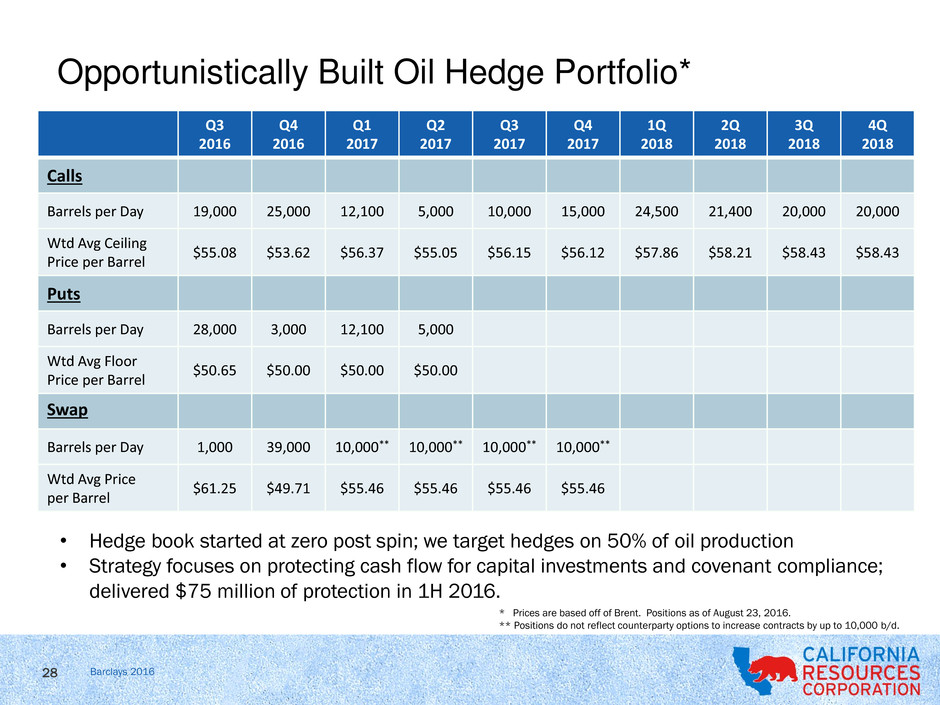
Barclays 2016
Opportunistically Built Oil Hedge Portfolio*
• Hedge book started at zero post spin; we target hedges on 50% of oil production
• Strategy focuses on protecting cash flow for capital investments and covenant compliance;
delivered $75 million of protection in 1H 2016.
Q3
2016
Q4
2016
Q1
2017
Q2
2017
Q3
2017
Q4
2017
1Q
2018
2Q
2018
3Q
2018
4Q
2018
Calls
Barrels per Day 19,000 25,000 12,100 5,000 10,000 15,000 24,500 21,400 20,000 20,000
Wtd Avg Ceiling
Price per Barrel
$55.08 $53.62 $56.37 $55.05 $56.15 $56.12 $57.86 $58.21 $58.43 $58.43
Puts
Barrels per Day 28,000 3,000 12,100 5,000
Wtd Avg Floor
Price per Barrel
$50.65 $50.00 $50.00 $50.00
Swap
Barrels per Day 1,000 39,000 10,000** 10,000** 10,000** 10,000**
Wtd Avg Price
per Barrel
$61.25 $49.71 $55.46 $55.46 $55.46 $55.46
28
* Prices are based off of Brent. Positions as of August 23, 2016.
** Positions do not reflect counterparty options to increase contracts by up to 10,000 b/d.
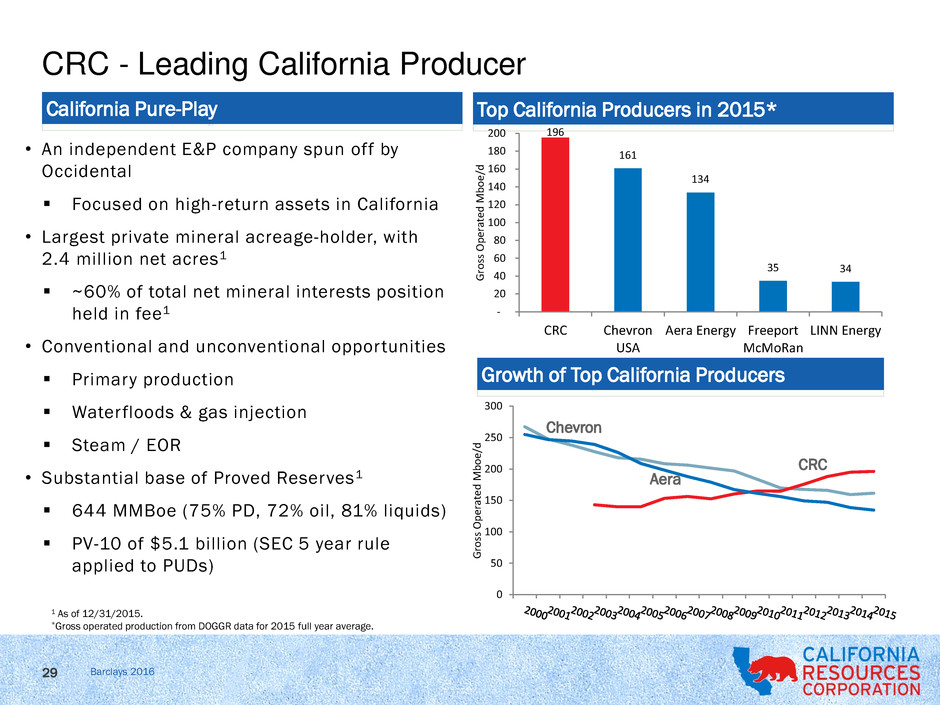
Barclays 2016
CRC - Leading California Producer
California Pure-Play Top California Producers in 2015*
• An independent E&P company spun off by
Occidental
Focused on high-return assets in California
• Largest private mineral acreage-holder, with
2.4 million net acres1
~60% of total net mineral interests position
held in fee1
• Conventional and unconventional opportunities
Primary production
Waterfloods & gas injection
Steam / EOR
• Substantial base of Proved Reserves1
644 MMBoe (75% PD, 72% oil, 81% liquids)
PV-10 of $5.1 billion (SEC 5 year rule
applied to PUDs)
1 As of 12/31/2015.
*Gross operated production from DOGGR data for 2015 full year average.
29
0
50
100
150
200
250
300
G
ro
ss
O
p
era
te
d
M
b
o
e/
d
Growth of Top California Producers
196
161
134
35 34
-
20
40
60
80
100
120
140
160
180
200
CRC Chevron
USA
Aera Energy Freeport
McMoRan
LINN Energy
G
ro
ss
O
p
era
te
d
M
b
o
e/
d
Aera
Chevron
CRC
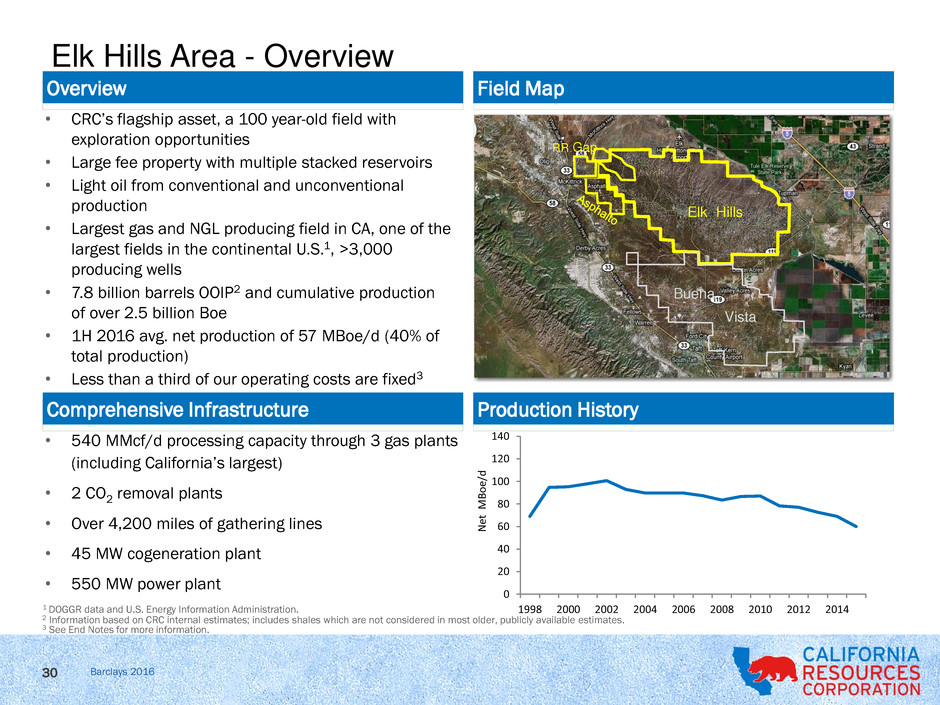
Barclays 2016
0
20
40
60
80
100
120
140
1998 2000 2002 2004 2006 2008 2010 2012 2014
N
et
MB
o
e/
d
• CRC’s flagship asset, a 100 year-old field with
exploration opportunities
• Large fee property with multiple stacked reservoirs
• Light oil from conventional and unconventional
production
• Largest gas and NGL producing field in CA, one of the
largest fields in the continental U.S.1, >3,000
producing wells
• 7.8 billion barrels OOIP2 and cumulative production
of over 2.5 billion Boe
• 1H 2016 avg. net production of 57 MBoe/d (40% of
total production)
• Less than a third of our operating costs are fixed3
• 540 MMcf/d processing capacity through 3 gas plants
(including California’s largest)
• 2 CO2 removal plants
• Over 4,200 miles of gathering lines
• 45 MW cogeneration plant
• 550 MW power plant
Overview
Comprehensive Infrastructure
Field Map
Production History
1 DOGGR data and U.S. Energy Information Administration.
Elk Hills
Buena
Vista
RR Gap
Elk Hills Area - Overview
2 Information based on CRC internal estimates; includes shales which are not considered in most older, publicly available estimates.
30
3 See End Notes for more information.
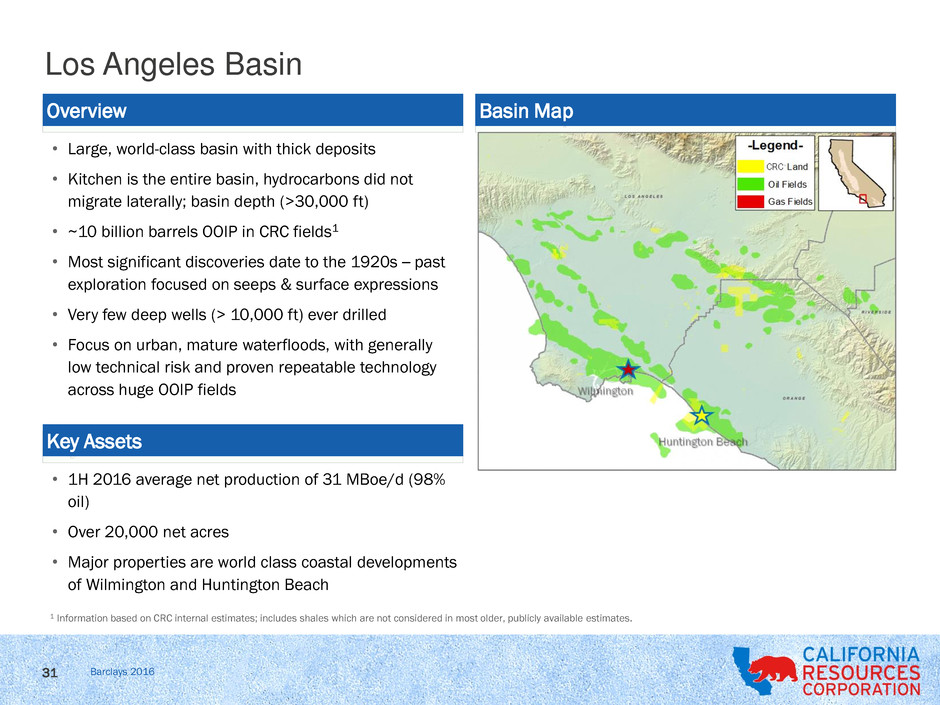
Barclays 2016
Los Angeles Basin
• Large, world-class basin with thick deposits
• Kitchen is the entire basin, hydrocarbons did not
migrate laterally; basin depth (>30,000 ft)
• ~10 billion barrels OOIP in CRC fields1
• Most significant discoveries date to the 1920s – past
exploration focused on seeps & surface expressions
• Very few deep wells (> 10,000 ft) ever drilled
• Focus on urban, mature waterfloods, with generally
low technical risk and proven repeatable technology
across huge OOIP fields
• 1H 2016 average net production of 31 MBoe/d (98%
oil)
• Over 20,000 net acres
• Major properties are world class coastal developments
of Wilmington and Huntington Beach
Overview
Key Assets
Basin Map
31
1 Information based on CRC internal estimates; includes shales which are not considered in most older, publicly available estimates.
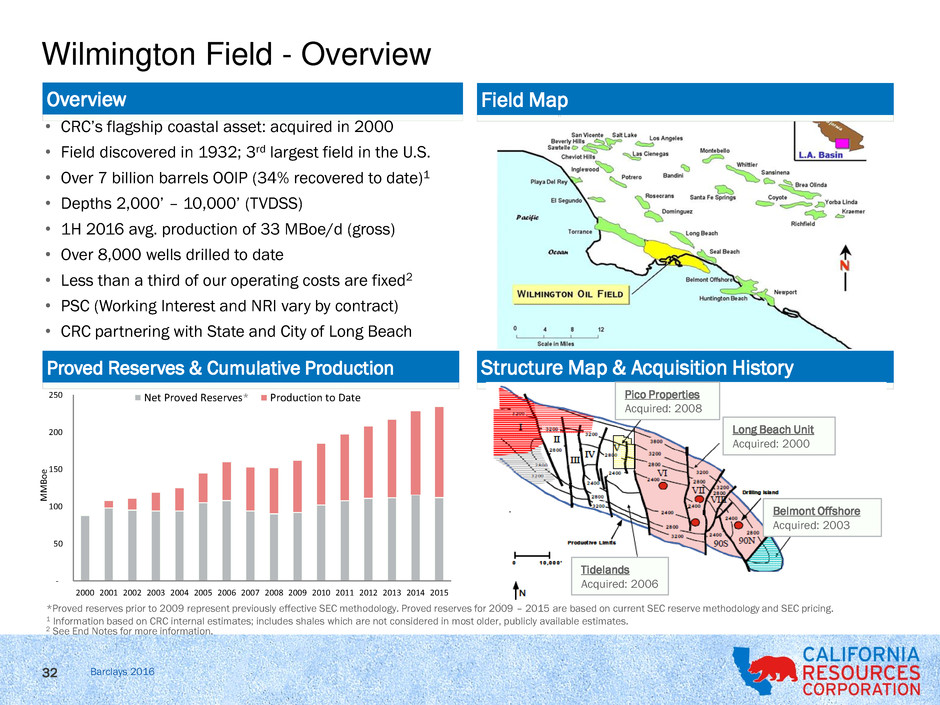
Barclays 2016
-
50
100
150
200
250
2000 2001 2002 2003 2004 2005 2006 2007 2008 2009 2010 2011 2012 2013 2014 2015
M
M
B
o
e
Net Proved Reserves Production to Date
Overview Field Map
Proved Reserves & Cumulative Production Structure Map & Acquisition History
*
• CRC’s flagship coastal asset: acquired in 2000
• Field discovered in 1932; 3rd largest field in the U.S.
• Over 7 billion barrels OOIP (34% recovered to date)1
• Depths 2,000’ – 10,000’ (TVDSS)
• 1H 2016 avg. production of 33 MBoe/d (gross)
• Over 8,000 wells drilled to date
• Less than a third of our operating costs are fixed2
• PSC (Working Interest and NRI vary by contract)
• CRC partnering with State and City of Long Beach
*Proved reserves prior to 2009 represent previously effective SEC methodology. Proved reserves for 2009 – 2015 are based on current SEC reserve methodology and SEC pricing.
1 Information based on CRC internal estimates; includes shales which are not considered in most older, publicly available estimates.
Tidelands
Acquired: 2006
Belmont Offshore
Acquired: 2003
Long Beach Unit
Acquired: 2000
Pico Properties
Acquired: 2008
Wilmington Field - Overview
32
2 See End Notes for more information.
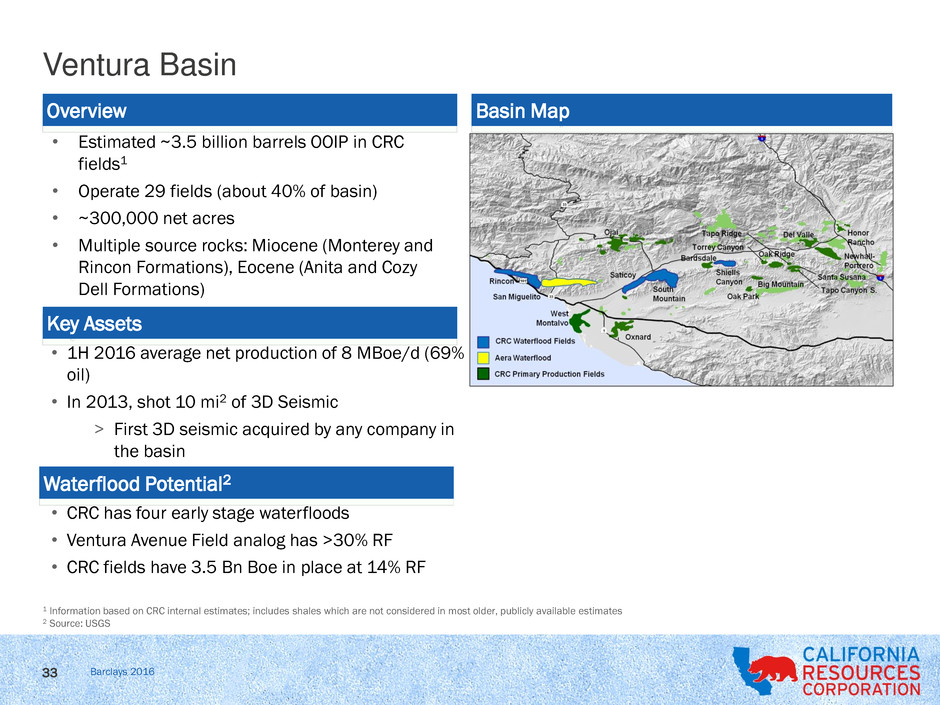
Barclays 2016
Ventura Basin
• Estimated ~3.5 billion barrels OOIP in CRC
fields1
• Operate 29 fields (about 40% of basin)
• ~300,000 net acres
• Multiple source rocks: Miocene (Monterey and
Rincon Formations), Eocene (Anita and Cozy
Dell Formations)
• 1H 2016 average net production of 8 MBoe/d (69%
oil)
• In 2013, shot 10 mi2 of 3D Seismic
> First 3D seismic acquired by any company in
the basin
Overview
Key Assets
Basin Map
• CRC has four early stage waterfloods
• Ventura Avenue Field analog has >30% RF
• CRC fields have 3.5 Bn Boe in place at 14% RF
Waterflood Potential2
1 Information based on CRC internal estimates; includes shales which are not considered in most older, publicly available estimates
2 Source: USGS
33
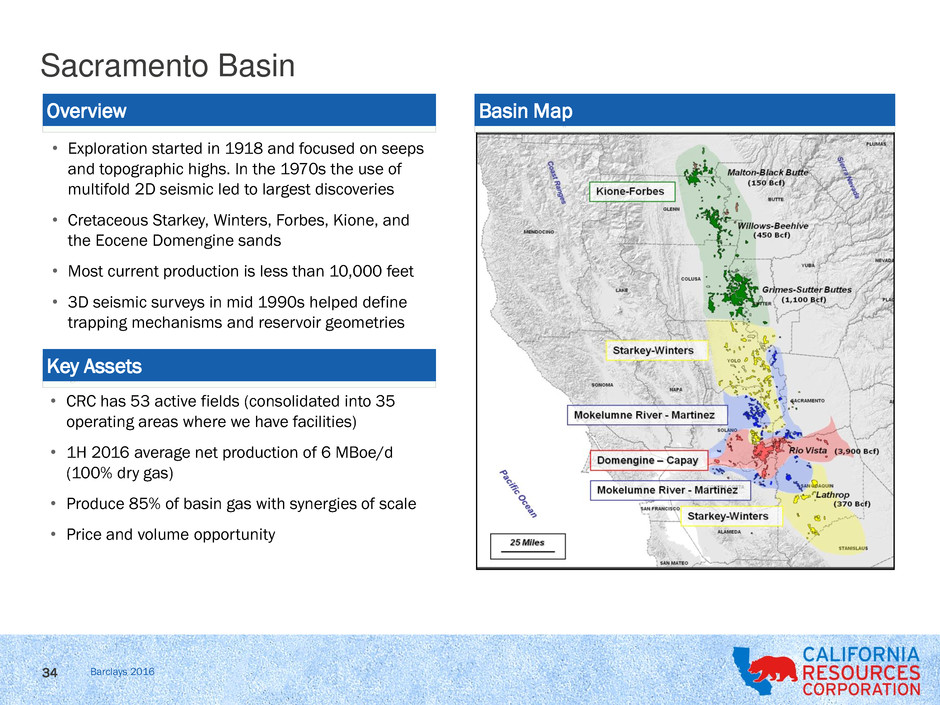
Barclays 2016
Sacramento Basin
• Exploration started in 1918 and focused on seeps
and topographic highs. In the 1970s the use of
multifold 2D seismic led to largest discoveries
• Cretaceous Starkey, Winters, Forbes, Kione, and
the Eocene Domengine sands
• Most current production is less than 10,000 feet
• 3D seismic surveys in mid 1990s helped define
trapping mechanisms and reservoir geometries
• CRC has 53 active fields (consolidated into 35
operating areas where we have facilities)
• 1H 2016 average net production of 6 MBoe/d
(100% dry gas)
• Produce 85% of basin gas with synergies of scale
• Price and volume opportunity
Overview
Key Assets
Basin Map
34
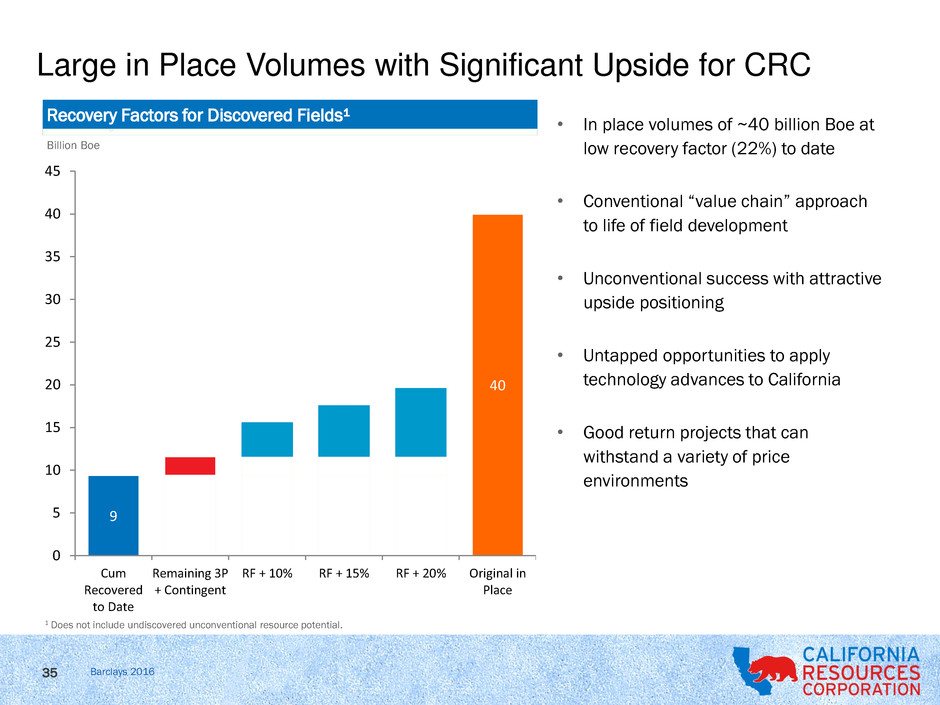
Barclays 2016
Recovery Factors for Discovered Fields¹
9
40
0
5
10
15
20
25
30
35
40
45
Cum
Recovered
to Date
Remaining 3P
+ Contingent
RF + 10% RF + 15% RF + 20% Original in
Place
Billion Boe
1 Does not include undiscovered unconventional resource potential.
• In place volumes of ~40 billion Boe at
low recovery factor (22%) to date
• Conventional “value chain” approach
to life of field development
• Unconventional success with attractive
upside positioning
• Untapped opportunities to apply
technology advances to California
• Good return projects that can
withstand a variety of price
environments
Large in Place Volumes with Significant Upside for CRC
35
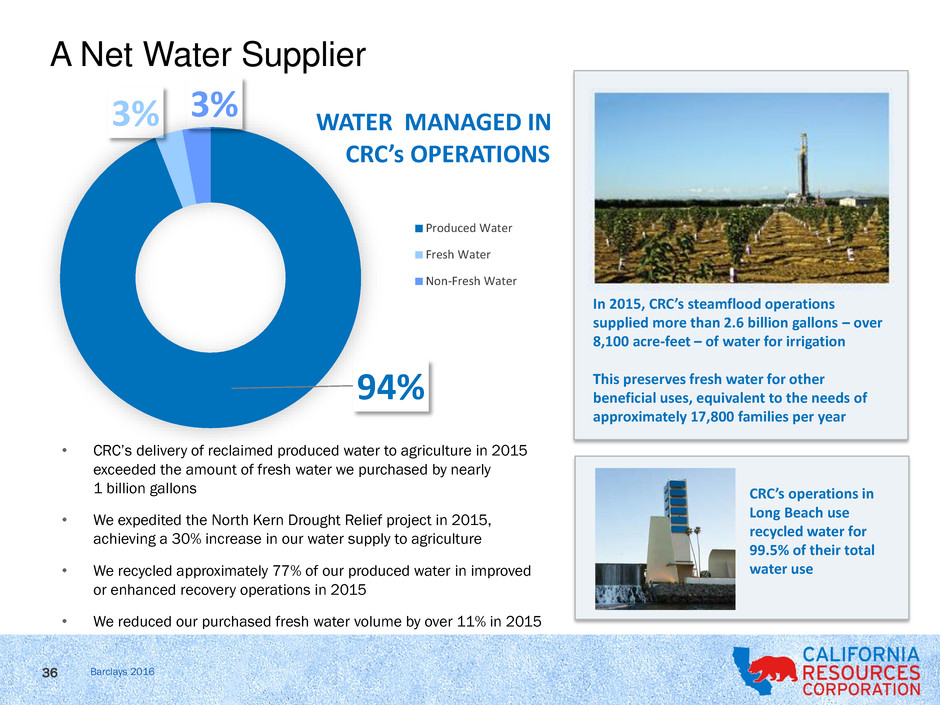
Barclays 2016
A Net Water Supplier
• CRC’s delivery of reclaimed produced water to agriculture in 2015
exceeded the amount of fresh water we purchased by nearly
1 billion gallons
• We expedited the North Kern Drought Relief project in 2015,
achieving a 30% increase in our water supply to agriculture
• We recycled approximately 77% of our produced water in improved
or enhanced recovery operations in 2015
• We reduced our purchased fresh water volume by over 11% in 2015
94%
3% 3% WATER MANAGED IN
CRC’s OPERATIONS
Produced Water
Fresh Water
Non-Fresh Water
In 2015, CRC’s steamflood operations
supplied more than 2.6 billion gallons – over
8,100 acre-feet – of water for irrigation
This preserves fresh water for other
beneficial uses, equivalent to the needs of
approximately 17,800 families per year
36
CRC’s operations in
Long Beach use
recycled water for
99.5% of their total
water use
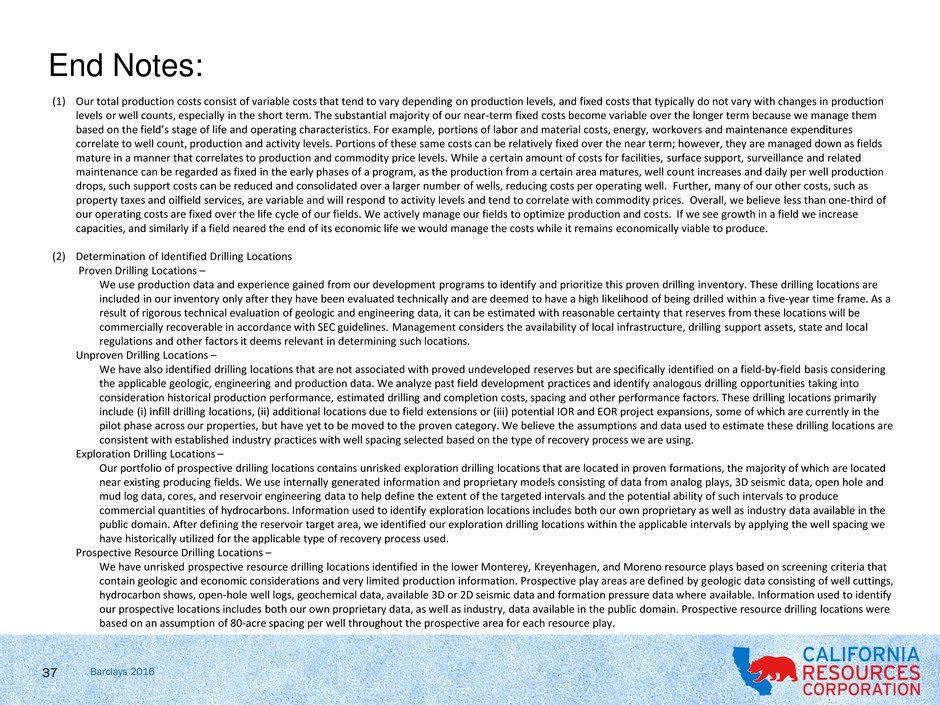
Barclays 2016
End Notes:
37
(1) Our total production costs consist of variable costs that tend to vary depending on production levels, and fixed costs that typically do not vary with changes in production
levels or well counts, especially in the short term. The substantial majority of our near-term fixed costs become variable over the longer term because we manage them
based on the field’s stage of life and operating characteristics. For example, portions of labor and material costs, energy, workovers and maintenance expenditures
correlate to well count, production and activity levels. Portions of these same costs can be relatively fixed over the near term; however, they are managed down as fields
mature in a manner that correlates to production and commodity price levels. While a certain amount of costs for facilities, surface support, surveillance and related
maintenance can be regarded as fixed in the early phases of a program, as the production from a certain area matures, well count increases and daily per well production
drops, such support costs can be reduced and consolidated over a larger number of wells, reducing costs per operating well. Further, many of our other costs, such as
property taxes and oilfield services, are variable and will respond to activity levels and tend to correlate with commodity prices. Overall, we believe less than one-third of
our operating costs are fixed over the life cycle of our fields. We actively manage our fields to optimize production and costs. If we see growth in a field we increase
capacities, and similarly if a field neared the end of its economic life we would manage the costs while it remains economically viable to produce.
(2) Determination of Identified Drilling Locations
Proven Drilling Locations –
We use production data and experience gained from our development programs to identify and prioritize this proven drilling inventory. These drilling locations are
included in our inventory only after they have been evaluated technically and are deemed to have a high likelihood of being drilled within a five-year time frame. As a
result of rigorous technical evaluation of geologic and engineering data, it can be estimated with reasonable certainty that reserves from these locations will be
commercially recoverable in accordance with SEC guidelines. Management considers the availability of local infrastructure, drilling support assets, state and local
regulations and other factors it deems relevant in determining such locations.
Unproven Drilling Locations –
We have also identified drilling locations that are not associated with proved undeveloped reserves but are specifically identified on a field-by-field basis considering
the applicable geologic, engineering and production data. We analyze past field development practices and identify analogous drilling opportunities taking into
consideration historical production performance, estimated drilling and completion costs, spacing and other performance factors. These drilling locations primarily
include (i) infill drilling locations, (ii) additional locations due to field extensions or (iii) potential IOR and EOR project expansions, some of which are currently in the
pilot phase across our properties, but have yet to be moved to the proven category. We believe the assumptions and data used to estimate these drilling locations are
consistent with established industry practices with well spacing selected based on the type of recovery process we are using.
Exploration Drilling Locations –
Our portfolio of prospective drilling locations contains unrisked exploration drilling locations that are located in proven formations, the majority of which are located
near existing producing fields. We use internally generated information and proprietary models consisting of data from analog plays, 3D seismic data, open hole and
mud log data, cores, and reservoir engineering data to help define the extent of the targeted intervals and the potential ability of such intervals to produce
commercial quantities of hydrocarbons. Information used to identify exploration locations includes both our own proprietary as well as industry data available in the
public domain. After defining the reservoir target area, we identified our exploration drilling locations within the applicable intervals by applying the well spacing we
have historically utilized for the applicable type of recovery process used.
Prospective Resource Drilling Locations –
We have unrisked prospective resource drilling locations identified in the lower Monterey, Kreyenhagen, and Moreno resource plays based on screening criteria that
contain geologic and economic considerations and very limited production information. Prospective play areas are defined by geologic data consisting of well cuttings,
hydrocarbon shows, open-hole well logs, geochemical data, available 3D or 2D seismic data and formation pressure data where available. Information used to identify
our prospective locations includes both our own proprietary data, as well as industry, data available in the public domain. Prospective resource drilling locations were
based on an assumption of 80-acre spacing per well throughout the prospective area for each resource play.
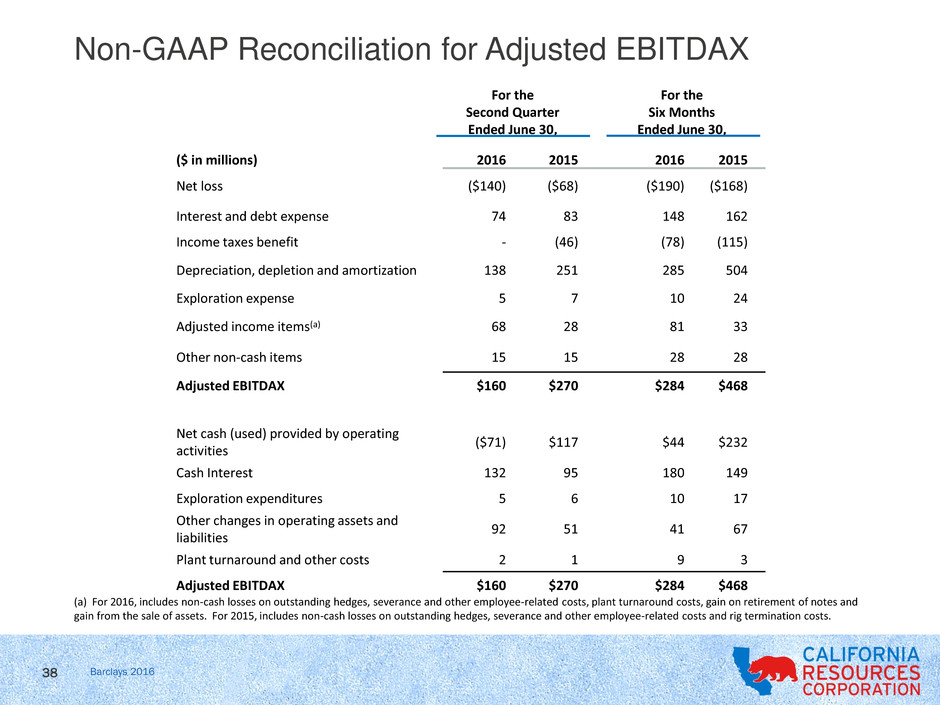
Barclays 2016
Non-GAAP Reconciliation for Adjusted EBITDAX
For the
Second Quarter
Ended June 30,
For the
Six Months
Ended June 30,
($ in millions) 2016 2015 2016 2015
Net loss ($140) ($68) ($190) ($168)
Interest and debt expense 74 83 148 162
Income taxes benefit - (46) (78) (115)
Depreciation, depletion and amortization 138 251 285 504
Exploration expense 5 7 10 24
Adjusted income items(a) 68 28 81 33
Other non-cash items 15 15 28 28
Adjusted EBITDAX $160 $270 $284 $468
Net cash (used) provided by operating
activities
($71) $117 $44 $232
Cash Interest 132 95 180 149
Exploration expenditures 5 6 10 17
Other changes in operating assets and
liabilities
92 51 41 67
Plant turnaround and other costs 2 1 9 3
Adjusted EBITDAX $160 $270 $284 $468
38
(a) For 2016, includes non-cash losses on outstanding hedges, severance and other employee-related costs, plant turnaround costs, gain on retirement of notes and
gain from the sale of assets. For 2015, includes non-cash losses on outstanding hedges, severance and other employee-related costs and rig termination costs.
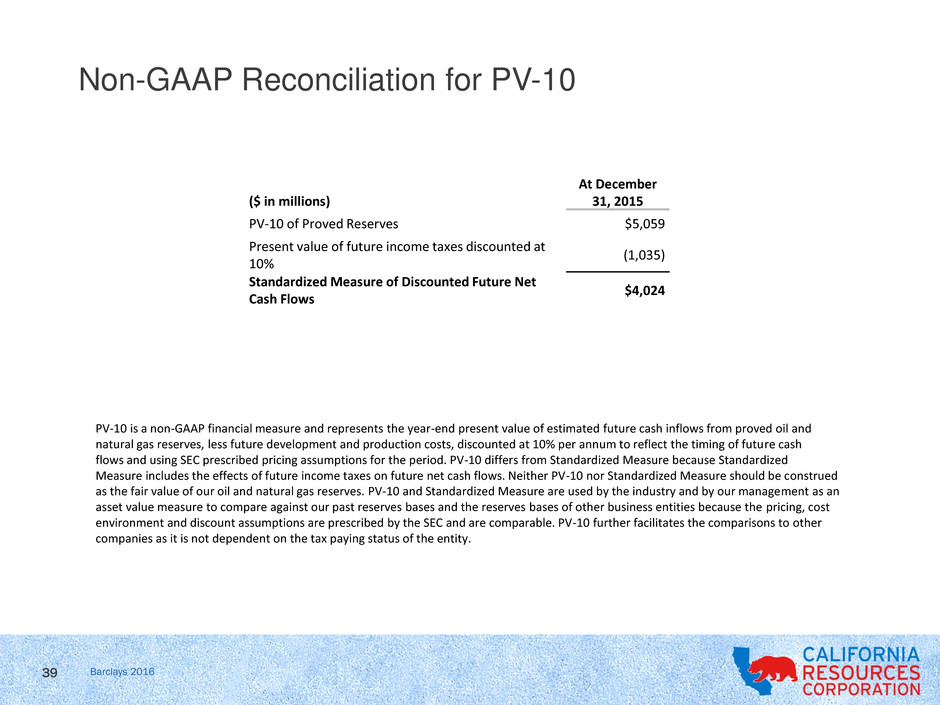
Barclays 2016
Non-GAAP Reconciliation for PV-10
($ in millions)
At December
31, 2015
PV-10 of Proved Reserves $5,059
Present value of future income taxes discounted at
10%
(1,035)
Standardized Measure of Discounted Future Net
Cash Flows
$4,024
PV-10 is a non-GAAP financial measure and represents the year-end present value of estimated future cash inflows from proved oil and
natural gas reserves, less future development and production costs, discounted at 10% per annum to reflect the timing of future cash
flows and using SEC prescribed pricing assumptions for the period. PV-10 differs from Standardized Measure because Standardized
Measure includes the effects of future income taxes on future net cash flows. Neither PV-10 nor Standardized Measure should be construed
as the fair value of our oil and natural gas reserves. PV-10 and Standardized Measure are used by the industry and by our management as an
asset value measure to compare against our past reserves bases and the reserves bases of other business entities because the pricing, cost
environment and discount assumptions are prescribed by the SEC and are comparable. PV-10 further facilitates the comparisons to other
companies as it is not dependent on the tax paying status of the entity.
39
